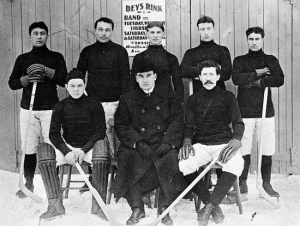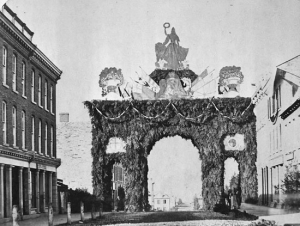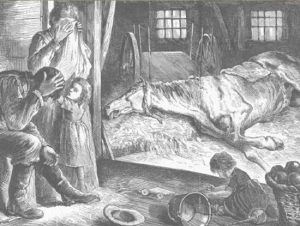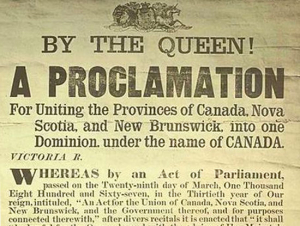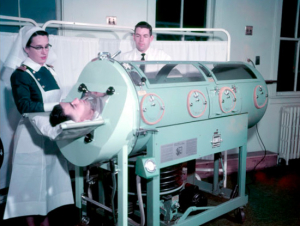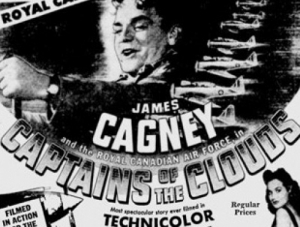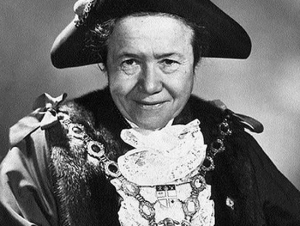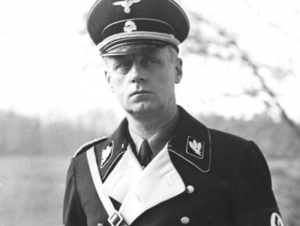James Powell
Dawson City Challenge
16 January 1905
At the beginning of the twentieth century, the rules of ice hockey were considerably different than they are today. For one thing, a team had seven players on the ice instead of the modern six. The extra player was known as the “rover.” The game itself was divided into two, thirty-minute halves, instead of three, twenty-minute periods. Forward passes were illegal. Similar to rugby, the puck-handler who found his progress blocked was forbidden to pass the puck forward to an open team mate. Pity the poor goalie too. He was virtually indistinguishable from other players, wearing little or no padding. At best, his shins were protected by cricket pads. The other team members didn’t have it easy though; line changes were a thing of the future.
Who could compete for the Stanley Cup was also very different. Instead of the Eastern and Western Conference champions of the National Hockey League playing in a best-of-seven series, the Cup was a “challenge” cup for amateur play. A hockey club, usually the winner of some league play, challenged the Cup holder for the trophy, typically in a best of three game series, or a two-game, total goals series. The winning team also got to take home the Cup, and only relinquished the trophy upon its defeat by a challenger.
In the fall of 1904, the reigning Stanley Cup champions, Ottawa’s Silver Seven, the forerunners of the Ottawa Senators, were challenged by an upstart team from Dawson City, Yukon called the Dawson City Nuggets, or sometimes the Dawson City Klondikers. The Cup challenge was organized by Colonel Joe Boyle, Dawson City’s number one citizen. Boyle, a larger-than-life character, had made a fortune in the Klondike Gold Rush of 1898 through mining concessions and other businesses. His nickname was “King of the Klondike.”
By 1904, however, Dawson City was in decline, the gold largely played out. Its population, which had topped 40,000 at the peak of the gold rush in 1898, had fallen to less than 5,000, though there were more settlers in the surrounding hinterland. Boyle, a one-time boxing promoter with a passion for hockey, put together a four-team league consisting of miners, prospectors, police and civil servants. The small league played at a newly-built, indoor rink that amazingly boasted an attached clubhouse, dressing rooms, showers, lounges and a dining room. The Dawson City Nuggets, an “all-star” team, were drawn from this ragtag bunch. Confident of their abilities, however, somebody came up with the idea, reputedly at a “knees up” in a local saloon, of challenging the Ottawa Hockey Club’s Silver Seven for the Stanley Cup.
This wasn’t as wacky an idea as it sounds. A number of good hockey players had come to the Klondike to seek their fortunes. As one press report of the time noted, the men “continued to play hockey when they were not ‘plucking gold nuggets.’” Coincidentally, many of the players were from the Ottawa area. The team’s captain, Weldy Young, was a legitimate star who had played for the Ottawa Hockey Club during the 1890s. The team’s rover, Dr Randy McLennan, also had considerable hockey experience, having played for Queen’s University in Kingston when it challenged the Montreal AAA team in a losing cause for the Stanley Cup in 1895. However, the Ottawa team was a formidable opponent. It had defeated the Montreal Wanderers for the Stanley Cup in March 1903, and had successfully defended it against five challengers over the following year.
For reasons that are unclear, the Ottawa Club accepted the cheeky challenge from the northerners to a best of three series to be held in January 1905 in Ottawa. Col. Boyle bankrolled the Nuggets, covering their travel and other expenses of $6,000, equivalent to about $125,000 in today’s money. With the team’s likely share of the box office from the Stanley Cup games expected to be only $2,000, he also organized a series of post-Cup exhibition games in eastern Canada and the United States to help re-coup his expenses. The Dawson City Nuggets became an instant media sensation throughout North America. The Montreal Gazette called their trek out east “the most gigantic trip every undertaken by a hockey team.” Ottawa’s Evening Journal said it was “the pluckiest challenge in the history of the Stanley Cup.”
Most of the team set out from Dawson City on 19 December 1904. They were originally supposed to leave several days earlier, but their departure was delayed by a federal election in the Yukon. As it was, the team left without Weldy Young. Employed by the government, he had to work over the election period and couldn’t get the time off. He later caught up with the rest of the players, too late, however, to play in the Stanley Cup series in Ottawa. The team’s number two player, Lionel Bennett, was also a no-show. He didn’t want to leave his wife’s bedside who had been injured in a sleigh accident.
Undeterred, the team set out on the 4,300 mile (6,900 kilometre) trek to Ottawa. The first leg of their voyage was to Whitehorse, a 330-mile slog through the wilderness, on bicycle, foot, and by sled. Despite the cold and overcoming frostbite, the men made good time. They covered 46 miles on their first day alone. But it took them nine days to get to Whitehorse, sheltering at night in cabins owned by the North West Mounted Police. From Whitehorse, they caught a train to Skagway, Alaska. Delayed two days by snow storms in the White Pass, the team missed their boat and had to wait an additional three days before catching a steamer to Seattle. They then backpacked to Vancouver. At Vancouver, they boarded the transcontinental Canadian Pacific train for Ottawa. Before leaving, Boyle sent a telegram to the Ottawa Hockey Club asking for the series to be postponed to allow the Nuggets to recover from their odyssey; the request was denied.
The Nuggets arrived in Ottawa on 11 January 1905, two days before their opening game at Dey’s Rink located at Gladstone and Bay Streets. The team was warmly greeted in Ottawa. The Ottawa Journal called the Dawson players “hardy Norsemen,” and opined that the “Yukon team was a sturdy lot” and would “bear themselves bravely.” The team took some light practice at the arena before the series began, as well as visited the Ottawa Amateur Athletic Club to watch boxing matches and an endurance contest.
The first game of the series was held on 13 January at 8.30pm. In goal for Dawson City was 17-year old Albert Forrest, originally from Trois Rivières, Quebec. Replacing the absent Weldy Young as team captain was Dr Randy McLennan (rover). The other players included Jim Johnstone (point), Lorne Hannay (cover point), Hector Smith (centre), George Kennedy (right wing) and Norman Watt (left wing). Joe Boyle acted as the team’s manager. At the other end of the ice, Dave Finnie was in goal for Ottawa. The other Silver Seven players included Arthur “Bones” Allan (point), Art Moore (cover point), Harry “Rat” Westwick (rover), Frank McGee (centre), Alf Smith (right wing) and Fred White (left wing). Bob Shillington was the team’s general manager.
The game was played to a capacity crowd of roughly 2,500 spectators. The Governor General, Lord Grey, dropped the puck to start play. Through the first half, the Nuggets, dressed in black sweaters with gold trim, were competitive, holding the Silver Seven, wearing their red, black and white jerseys, to only three goals to their one. But the Nuggets began to flag in the second half, the effects of their trip becoming apparent. Penalties didn’t help either. A punch-up in the first half sent Norman Watt of the Nuggets and Ottawa’s Alf Smith off for ten minutes each for fighting. Tempers deteriorated further during the second half. When Art Moore, Ottawa’s cover point, tripped Watt, Watt retaliated. After he picked himself off the ice, Watt skated over to Moore and smashed him over his head with his stick, knocking him out cold for ten minutes. Two quick Ottawa goals followed. The final score was a lopsided 9-2 decision in Ottawa’s favour; Alf Smith tallied for four goals, Rat Westwick and Fred White each got two, while Frank McGee scored once. For Dawson City, Randy McLennan and George Kennedy retaliated.
Notwithstanding Watt’s brutal assault on Moore and the other fights, the Ottawa Evening Journal admired the sportsmanship displayed by both teams. In the newspaper’s description of the game, the reporter commented: “It was rather a novelty to the Ottawa public to see such a wholesome, even-tempered exhibition and it went down very well with the audience. More power to you boys!” One wonders what rough games were like during that era.
The second game of the series took place two days later on 16 January 1905. Both teams made modest changes to their line-ups. For the Nuggets, Dave Fairburn replaced Randy McLennan as rover. Harvey Pulford, the Silver Seven captain took over on point from “Bones” Allan. The national press didn’t rate the Nuggets chances very highly. The St John Daily Sun commented that the Stanley Cup would likely stay east. The newspaper commented that although the Klondikers had demonstrated they could handle the puck during the first game, the team had been “outskated, out-generalled, out-pointed in very department” by the Ottawa club. Still, the Dawson City newspaper, Yukon World, remained optimistic saying that the Klondike team had “a good chance.” The paper was wrong. Ottawa destroyed the Nuggets in the most lop-sided victory in the history of the Stanley Cup, defeating the northerners 23-2 in front of another capacity crowd at Dey’s Rink. Reports were pretty unanimous that Ottawa would have run the score up even higher if it hadn’t been for the strong goal-tending of young Albert Forrest.
Frank McGee, Ottawa’s centre, scored fourteen times, another record that still stands today. Eight of those goals were scored consecutively in less than nine minutes in the second half. McGee, an Ottawa native, was the nephew of D’Arcy McGee, the father of Confederation who was assassinated in 1868. McGee was a well-rounded athlete who had played football for the Ottawa Rough Riders during the 1890s. He had only one eye; he lost the other one in 1900 to a high stick. With a full time job as a public servant, he retired from hockey in 1906 at the tender age of 23 years. Despite his handicap, he enlisted during World War I after cheating on his vision test. He died in 1916 at the Battle of the Somme.
The evening after the blow-out, second game, the Ottawa Hockey Club hosted a party for the visiting Nuggets at the Ottawa Amateur Athletic Club, with George Murphy, president of the Ottawa Club acting as toastmaster. It must have been quite an event. The Stanley Cup, filled with champagne, was passed around the table repeatedly. Later, somebody drop-kicked the trophy onto the frozen Rideau Canal.
The team from the Klondike left Ottawa for their tour of eastern Canada and the United States. With the return of Weldy Young to the team, the Nuggets had a modicum of success, though not enough to mitigate their overwhelming defeat in Ottawa. The team then disappeared from history, though not before getting its name engraved on the Stanley Cup for all time.
In 1997 a Dawson City team took on an Ottawa Senators Alumni team in a re-enactment of the 1905 game at the Corel Centre (now the Canadian Tire Centre) in Ottawa. Retracing the steps of their predecessors, the Dawson team travelled by dog sled and snowmobile from Dawson City, to Whitehorse, to Skagway and then by ferry to Seattle, before heading to Vancouver, and finally Ottawa. Before a crowd of 6,000 the visitors were once again thumped, this time 18-0. The proceeds of the charity event, split between the two teams, went to the Ottawa Heart Institute, the Yukon Special Olympics, and Yukon Minor Hockey.
Sources:
Story suggested by André Laflamme, Ottawa Free Tours, http://www.ottawafreetour.com
Gaffin Jane, 2006. Joe Boyle: The SuperHero of the Klondike Gold Rush, http://www.diarmani.com/Articles/Gaffin/Joe%20Boyle%20--%20SuperHero%20of%20the%20Klondike%20Goldfields.htm
Gates, Michael, 2010. “The game that almost brought the Stanley Cup to Dawson,” Yukon News, 22 January.
Globe, (The), 1904. “Coming of the Gold-Diggers,” 29 November.
—————-, 1905. “Ottawa Outclassed Dawson.” 17 January.
Levett, Bruce. 1989. “2-game Series took month’s trek.” Ottawa Citizen, 27 August.
McKinley, Michael, 2000. Putting A Roof On Winter, Greystone Books: Vancouver, Toronto, New York.
Montreal Gazette (The), 1904 “The Stanley Cup Dates,” 23 November.
—————————-, 1905. “Story of the Stanley Cup,” 18 January.
Ottawa Evening Journal (The), 1905. “Overcame All Hardships,” 13 January.
————————————, 1905. “Ottawas Victorious In the First Stanley Cup Match,” 14 January.
———————————–, 1905. “The Stanley Cup Will Not Be Going To The Klondike,” 17 January.
———————————-, 1905. “J.P. Dickson Threw Down Gauntlet To The C.A.A.U. 18 January.
Pelletier, Joe, 2014. “Great Moments in Hockey History: Stanley Cup Challenge from the Yukon,” Greatest Hockey Legends.com, 9 May.
Pittsburgh Press (The), 1905. “Hockey Flashes,” 13 January.
Rodgers, Andrew, 2011. “Dawson City Nuggets and the Ottawa Senators Alumni: Interview with Award-Winning Author Don Reddick,” TVOS, 16 March
St John Daily Sun, 1905. “Stanley Cup Will Probably Stay East,” 14 January.
Yukon World, 1904. “Dawson’s Champions And The Cup,” 18 December.
—————-, 1905. “Klondike Hockey Team Creates Great Interest In Ottawa,” 13 January.
—————, 1905. “Klondike Hockey Team Defeated In Extremely Rough Game In the Presence Of Thousands Of People,” 14 January.
—————, 1905. “Klondike Team Has Good Chance In The Game Monday Night,” 15 January.
————–, 1905, “Klondike Hockey Meet An Overwhelming Defeat At The Capital,” 17 January.
Story written by James Powell, the author of the blog Today in Ottawa's History.
Retired from the Bank of Canada, James is the author or co-author of three books dealing with some aspect of Canadian history. These comprise: A History of the Canadian Dollar, 2005, Bank of Canada, The Bank of Canada of James Elliott Coyne: Challenges, Confrontation and Change,” 2009, Queen’s University Press, and with Jill Moxley, Faking It! A History of Counterfeiting in Canada, 2013, General Store Publishing House, Renfrew, Ontario. James is a Director of The Historical Society of Ottawa.
First Royal Visit
1 September 1860
In May 1859, the Legislature of the Province of Canada invited Queen Victoria and her husband Prince Albert to come to British North America “to witness the progress and prosperity of this distant part of your dominions.” Specifically, the Legislature hoped that the Queen would officially open the Victoria Bridge (le pont Victoria), the first bridge to span the St Lawrence River, which joined Montreal on the north shore with St Lambert on the south shore, that was nearing completion. The visit would also “afford the opportunity the inhabitants [of the Province of Canada] of uniting in their expression of loyalty and attachment to the Throne and Empire.”
Queen Victoria regretfully declined the invitation, saying that “her duties at the seat of Empire prevent so long an absence.” Transatlantic travel in the mid nineteenth century was still an arduous journey, taking two weeks or longer, even if the weather was favourable. Instead, she offered to send her eldest son, Albert Edward, the Prince of Wales. It would be a “coming out” event for the nineteen-year old prince who would later become King Edward VII. Her suggestion was enthusiastically embraced. On hearing that the prince would be visiting British North America, U.S. President Buchanan invited him to tour the United States as well.
The extended North American tour took the young prince to all the major cities of the British colonies of North America, as well as to the major cities of the United States as far west as St Louis, Missouri. The prince’s tour naturally included Ottawa, the city selected by his mother to be the new capital of the United Province of Canada in 1857. Fortuitously, construction of the new Parliamentary buildings had commenced at the end of 1859, and the prince was invited to lay the cornerstone of the Legislature building while he was in the city.
The Prince of Wales departed England for North America on 10 July 1860 on board HMS Hero, a 91-gun, screw and sail powered ship of the line, accompanied by HMS Ariadne, a wooden, screw frigate, and was met in Newfoundland by the screw steam sloop HMB Flying Fish. On board the Hero was a true hero–William Hall. The son of a slave who had escaped to Canada during the War of 1812, Hall, was the first Canadian seaman and the first black man to receive the Victoria Cross for gallantry. He received the honour for heroism at the siege of Lucknow in 1857 during the Indian Mutiny.
The Prince and his entourage arrived in St John’s during the evening of 23 July, after having encountered heavy seas and dense fog on the crossing. Although the Newfoundland government knew roughly when the prince’s would arrive, his ship’s entrance through the Narrows caught people by surprise; ship-to-shore telegraph communications was still in the distant future. That night, the city hastily finished erecting ceremonial arches made of evergreens, and put up flags and bunting, in preparation for the prince’s official landing the next morning.
Over the following month, the prince made his way across the Atlantic colonies with considerable pomp and ceremony. After St John’s, he visited Halifax, St John, Fredericton, and Charlottetown, before the royal squadron left for the Province of Canada. It arrived in Canadian waters on 13 August where it was met by the Governor General, Sir Edmund Head, and members of the Canadian government on board two Canadian steamers in the mouth of the St Lawrence River. The flotilla reached Quebec City on 18 August. The first major event was a reception at Parliament House where he was greeted by the Legislative Council and the Legislative Assembly. The prince then knighted the speakers of the two houses of Parliament. He subsequently visited Trois Rivières and then Montreal, where he officially opened le pont Victoria, laying the cornerstone to the entrance to the bridge as well as setting in place a ceremonial “last rivet.” In truth, the bridge, the longest in the world at the time, had been completed the previous year, and was already open for rail traffic.
After a tour of the Eastern Townships, Prince Edward proceeded from Montreal to Ottawa on 31 August. As there was no direct train link, he travelled by way of a special train to Ste Anne-De-Bellevue, followed by boat trip to Carillion, another train ride to Grenville, where he picked up the steamer Phoenix for the last stage of his journey up the Ottawa River. He arrived in Ottawa at 7pm to be met by an armada of one hundred and fifty canoes paddled by several hundred lumbermen dressed in white trousers and red shirts with blue facing. The canoes, flying banners, escorted the steamer the last two miles to the Ottawa wharf. When the Phoenix rounded the Rockcliffe promontory, the Ottawa Field Battery fired a royal salute.
Little Ottawa, with a population of less than 15,000 people, was abuzz with excitement. Nothing like this had ever happened in the rough-and-tumble lumber town. Bunting and flags bedecked every home and office building. Ceremonial arches were built along the route to be taken by the prince and his party through the city. One such arch, spanning Spark’s Street near the Bate building, was constructed of evergreens, interspersed with heraldic shields, mottos, and 60 foot towers. It was topped by two immense urns of flowers and a huge statue of the goddess Minerva clad in armour.
In front of St Andrew’s Presbyterian Church, “four chaste and elegant towers” were erected across Wellington Street “draped and festooned at their caps with cornucopias of flowers, royal standards, shields, and various other appropriate devices.” At the Ottawa end of the Union Suspension Bridge (where today’s Chaudière Bridge stands) to Hull was a massive wooden arch made of 180,000 feet of sawn lumber assembled without a single nail. The wood, worth $3,000, a huge sum in those days, was provided by the company Perley, Pattee & Brown. The suspension bridge itself was decorated with transparencies of the Queen, the Prince Consort, and the Prince of Wales which were illuminated after dusk. Similarly, Sappers’ Bridge, which connected Lower Town and Upper Town, was festooned with hundreds of Chinese lanterns. The Ottawa Citizen commented that “Ottawa appeared lovely and anxious as a bride awaiting the arrival of the bride-groom to complete her joy.”
Unfortunately, the start to the prince’s Ottawa visit was marred by a torrential rain shower just as Mayor Alexander Workman, dressed in his robes of office, commenced his dock-side welcome speech. While he soldiered on despite the soaking, the thousands of onlookers scattered for cover. After the prince thanked the mayor, he and his entourage were taken by carriage to the Victoria House Hotel at the corner of Wellington and O’Connor Streets. In their wake followed a somewhat bedraggled parade of soldiers, firemen, and government employees.
But the next day was bright and sunny for the laying of Parliament’s cornerstone. At 11am, the prince, followed by the Governor General, members of the prince’s party, Canadian Cabinet ministers dressed in blue and gold, and other dignitaries, entered the Parliamentary grounds through yet another triumphal arch; this one decorated in a Gothic style. The cornerstone ceremony was held on a dais under an elaborate canopy, surrounded by wooden bleachers to allow several thousand Ottawa citizens to view the proceedings. Following prayers offered by the chaplain to the Legislative Council, the prince approached the white Canadian marble stone. It bore the inscription This corner stone of the building intended to receive The Legislature of Canada was laid by Albert Edward, The Prince of Wales, on the first day of September MDCCCLX. The stone was suspended from a pulley above a Nepean limestone block in which there was a cavity. Into the cavity was placed a glass bottle containing a parchment scroll detailing the cornerstone ceremony and the names of the day’s participants. A collection of British and Canadian coins were also placed in the hole. The clerk of the works then supervised the laying of mortar, with the prince providing the last touch with a silver trowel engraved with a picture of the Parliament buildings. After the cornerstone was lowered into position, the prince tapped the stone three times. Following more prayers, and after officials had checked the stone with a plumb in the shape of a harp, and a level held by a lion and unicorn, the prince declared the stone to have been well and truly laid. At the end of the ceremony, Thomas Fuller and Chilion Jones of Toronto and Thomas Stent and Augustus Lever of Ottawa, the architects of the three Parliament buildings under construction, were presented to the prince. The royal party then went to view a three-dimensional model of the future library made by Charles Emil Zollikofer, a Swedish-born sculptor.
After a lunch hosted by the legislature in a wooden building on the Parliamentary grounds, the afternoon was taken up with fun and games. After the prince and his entourage had toured the city on horseback to admire the city’s decorations and the many triumphal arches erected for the occasion, they were taken to the Chaudière Falls for a singular Ottawa experience—a ride down the Government log slide used to send wood down river to avoid the falls. Two cribs of timber had been constructed to accommodate the royal party and journalists. Cheered by thousands who stood on the shore or on the many bridges over the slide, the prince shot through it to be met by hundreds of canoes mid river. While the two cribs descended without incident, the Ottawa Citizen reported that “the visages of some of the occupants of the cribs were considerable elongated on descending the first shoot.” A regatta with several canoe races followed.
The evening was marked by a very curious event—a mounted torchlight procession of “physiocarnivalogicalists” to the residence of the Prince of Wales. The members of this obscure order, who billed themselves as “the tribes of Allobrentio Forgissario,” were dressed in some sort of costume. The procession was the source of considerable amusement on the part of onlookers. On reaching the prince’s residence, the group raised a loud cheer, which the prince acknowledged through the window, before they dispersed.
After Sunday services at Christ Church (the predecessor of the current Anglican cathedral) the following morning, the prince visited Rideau Hall, the home of John McKay, the noted New Edinburgh lumber baron, and toured its magnificent grounds. Five years later, the Canadian government leased the mansion for the home of the Governor General; it purchased the home in 1868.
At 8am, Monday, 3 September, the prince and his party, escorted by the Durnham Light Infantry, left Ottawa for Brockville, the next stop on the Canadian leg of his North American tour, via Aylmer, Chats, and Armprior. He did not get back to Britain until the middle of November.
Fifty-six years to the day after the Prince of Wales had laid the cornerstone, his brother, the Duke of Connaught, re-laid it as the cornerstone of the new Parliament Building that replaced the original building, gutted in a mysterious fire in February 1916.
Sources:
Cellem, Robert, 1861. Visit Of His Royal Highness The Prince Of Wales To The British American Provinces And United States In The Year 1860, Henry Rowsell: Toronto.
The Ottawa Citizen, 1860. “Preparing To Receive The Prince! The Council & Citizens At Work!” 18 August.
———————–, 1860. “On Preparations To Receive H.R.H. The Prince of Wales,” 1 September.
————————, 1860. “The Prince in Ottawa,” 8 September.
Ottawa Journal (The), 1972. “Royal Nay hero was slave’s son,” 15 November.
Images: HMS Hero, anonymous, From Edward VII His Life and Times, published 1910.
Cornerstone Laying Ceremony, 1860, City of Ottawa Archives,
Lumbermen’s Arch, Illustrated London News.
Story written by James Powell, the author of the blog Today in Ottawa's History.
Retired from the Bank of Canada, James is the author or co-author of three books dealing with some aspect of Canadian history. These comprise: A History of the Canadian Dollar, 2005, Bank of Canada, The Bank of Canada of James Elliott Coyne: Challenges, Confrontation and Change,” 2009, Queen’s University Press, and with Jill Moxley, Faking It! A History of Counterfeiting in Canada, 2013, General Store Publishing House, Renfrew, Ontario. James is a Director of The Historical Society of Ottawa.
The Great Epizootic
12 October 1872
Imagine waking up one morning to discover that all motor vehicles had stopped working—no buses, no cars, no trucks, and no airplanes. People wouldn’t be able to get to work or school unless they lived close by. There would be no deliveries of food and merchandise to stores. Farmers would be left with mounds of rotting produce in the field, while factories would grind to a halt owing to a dearth of spare parts and absent workers. Meanwhile, police, firefighters and other emergency response workers would be unable to respond to urgent calls for help. Government would cease to function (okay, there might be an upside). In short, it would be a nightmare.
Rather than being a script worthy of a Hollywood post-apocalyptic movie, this effectively happened during the autumn of 1872, with disastrous consequences right across North America. It all started about fifteen miles north of Toronto during late September of that year. Horses in the townships of York, Scarborough and Markham began to sicken, coming down with a sore throat, a slight swelling of the glands, a severe hacking cough, a brownish-yellow discharge from the nose, a loss of appetite and general feebleness. Veterinaries hadn’t seen anything like it before. On 30 September, Andrew Smith, veterinary surgeon of the Ontario Veterinary College in Toronto, found fourteen stricken horses in one stable. Three days later, three-quarters of the horses in the district were infected.
The disease quickly spread to Toronto and beyond. It was reported in Ottawa on 12 October, and within a month had reached the east coast. Only Prince Edward Island, cut off from the mainland, escaped the disease. Horses in the United States also began to sicken, the disease striking Buffalo and Detroit by 13 October, and spreading within days to all the major cities on the eastern seaboard. The illness was identified in Chicago on 29 October after a number of horses imported from Toronto a few days earlier fell ill. By mid-March 1873, the disease had reached all the way to California, in the process disrupting a war between the U.S. cavalry and Apache warriors underway in Arizona Territory. With their horses incapacitated, cavalrymen and warriors fought on foot. A year after the Toronto-area outbreak, the illness had spread south to Nicaragua in Central America. The epidemic became known as the “Great Epizootic,” since it was an epidemic than infected animals, or “Canadian horse distemper.”
The horses were ill with equine influenza which we now know is caused by two types of related viruses, equine 1 (H7N7) and equine 2 (H3N8). But at the time, it was widely believed that the disease was due to something in the air. The Ottawa Daily Citizen reported that it was the opinion of a well-known veterinary surgeon that the disease was caused by atmospheric influences, “probably having some connection with [] recent thunderstorms.” The disease was typically not fatal, having a mortality rate of 1-3 per cent though it reached 10 per cent in some areas. However, the morbidity rate approached 100 per cent. Horses were left incapacitated for up to a month, hobbling transportation across the continent.
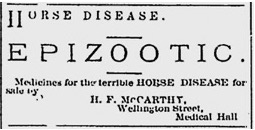 Within ten days of its first appearance in Ottawa, the situation had become serious in the capital, with the disease having “assumed a violent form as to cause considerable anxiety to horse owners.” All public livery stables were affected, as were an increasing number of stables owned by private citizens. By 21 October, veterinaries were dealing with hundreds of cases each day. It was estimated that fewer than 50 horses in the Ottawa region were unaffected. The horse-drawn street railway service that provided public transit from New Edinburgh through downtown to LeBreton Flats was temporarily suspended when all but six of its horses came down with influenza. One died.
Within ten days of its first appearance in Ottawa, the situation had become serious in the capital, with the disease having “assumed a violent form as to cause considerable anxiety to horse owners.” All public livery stables were affected, as were an increasing number of stables owned by private citizens. By 21 October, veterinaries were dealing with hundreds of cases each day. It was estimated that fewer than 50 horses in the Ottawa region were unaffected. The horse-drawn street railway service that provided public transit from New Edinburgh through downtown to LeBreton Flats was temporarily suspended when all but six of its horses came down with influenza. One died.
The Ottawa Daily Citizen recommended that infected horses should be kept warm in well-ventilated stables and fed soft food, such as oatmeal, boiled oats, or gruel. To promote an appetite, the newspaper suggested that owners try to temp sick horses with a carrot or apple. It also recommended cleaning out stables with bromo-chloralum, a deodorant and disinfectant. According for an advertisement for the product, it protected against “atmospheric influences which contribute to the spreading of disease.”
Small-town Ottawa got off lightly. Big U.S. cities like New York City and Boston, where horses were crammed together in dirty, multi-storied, urban stables, fared far worse. In New York City, more than 30,000 horses sickened within the course of a few days. At least 1,400 animals died of the disease. City transit failed, a major inconvenience for people living in the suburbs. Businesses and draymen, who transported goods on flat-bed wagons, were reported to be the worst affected. In Boston, oxen were brought in to replace sick horses on some transit lines. Tragically, on 9 November 1872, a fire started in a hoop-skirt factory in downtown Boston. In normal circumstances, it would have been easily contained. However, with all its horses down with the flu, the fire service was unable to respond in time, and the fire quickly got out of control. More than 775 buildings housing in excess of 1,000 businesses were destroyed. As many as twenty people perished.
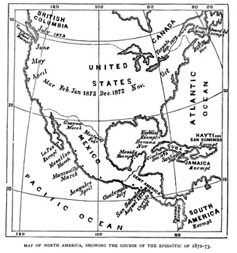 Epizootic Map of North America showing the spread of epizootic
Epizootic Map of North America showing the spread of epizootic
A. Judson, 1873. "History and Course of the Epizootic Among Horses Upon the North American Continent, 1872-73"The economic consequences of the disease as it spread across the continent were immense. In addition to cities coming to a virtual standstill for close to a month, traffic on the important Erie Canal from New York to Buffalo came to a halt as the horses that pulled the barges sickened. Even railways were affected as they ran out of coal that was shipped to rail terminals by horse-drawn wagons. Things got so bad that the United States was forced to import healthy horses from Mexico. Many economists believe that the Great Epizootic set the stage for the “Panic” of 1873, an economic depression that lasted for six years. The disease underscored the fragility of an animal-dependent economy.
The epidemic was the first disease whose advance was closely tracked across a continent. In the process, it became abundantly clear that “atmospheric conditions” had nothing to do with the contagion. A study of the disease debunked the idea that “cold, heat, humidity, season, climate, or altitude” or any other “unrecognized atmospheric conditions” had any bearing on the disease. Rather, the disease was spread “by virtue of its communicability.” Everywhere the disease struck was in contact with other places by means of horses or mules. Supporting this conclusion was the fact that isolated places, such as Prince Edward Island in the east or Vancouver Island in the west, were spared the disease; PEI was cut off due to bad winter weather, while a quarantine against the importation of horses was established on Vancouver Island. This analysis helped overturn the “miasma” theory of disease, which attributed illnesses to poisonous vapours, in favour of the “germ theory” of disease. It also set the stage for a better understanding of how disease is transmitted among humans, something that would become of vital importance less than fifty years later with the spread of the Spanish flu, a similar human disease that conservatively killed fifty million people at the end of World War I.
Sources:
Churcher, C. 2014, “Local Railway Items from Ottawa newspapers—1872,” The Ottawa Daily Citizen, 1872. “Ottawa City Passenger,” 19 October.
——————–, 2014, “Local Railway Items from Ottawa newspapers—1872,” The Ottawa Free Press, 1872, “Ottawa City Passenger,” 23 October.
Facts on File, 2014. Great Epizootic, Entry 602.
Judson, Adoniram, B. M.D., 1873. “History and Course of the Epizootic Among Horses Upon The North American Continent, 1872-73,” American Public Health Association, Public Health, Reports and Papers, 1873.
Heritage Restorations, H2012. “The Great Epizootic of 1872,” SustainLife Quarterly Journal, (Fall), Ploughshares Institute for Sustainable Culture.
Horsetalk, 2014. “How Equine Flu brought the US to a standstill,” 17 February.
Murnane, Brigadier Dr. Thomas, 2014. James Law, America’s First Veterinary Epidemiologist and The Equine Influenza Epizootic of 1872, The Long Riders Guild Academic Foundation.
Passing Strangeness, 2009. The Great Epizootic, 13 May,.
The Ottawa Daily Citizen, 1872. “Epizootic,” 21 October.
The Public Ledger, 1872. “The Epizootic in the United States,” 16 November.
Story written by James Powell, the author of the blog Today in Ottawa's History.
Retired from the Bank of Canada, James is the author or co-author of three books dealing with some aspect of Canadian history. These comprise: A History of the Canadian Dollar, 2005, Bank of Canada, The Bank of Canada of James Elliott Coyne: Challenges, Confrontation and Change,” 2009, Queen’s University Press, and with Jill Moxley, Faking It! A History of Counterfeiting in Canada, 2013, General Store Publishing House, Renfrew, Ontario. James is a Director of The Historical Society of Ottawa.
Canada’s Birthday 1 July 1867
1 July 1867
Each 1 July, Canadians across the country celebrate Canada’s birthday with cultural events and fireworks. The anniversary, which officially became Canada Day in 1982, was originally known as Dominion Day. Nowhere is the national holiday more sumptuously celebrated than in Ottawa, the nation’s capital. On the greensward in front of the Parliament buildings, thousands of patriotic Canadians flock to see the “Changing of the Guard,” performed by the Governor General’s Foot Guards dressed in their traditional scarlet tunics and bearskin hats. Canadian performing artists entertain the crowds through the day on a large stage specially erected for the occasion. After dusk, Parliament Hill is lit up with a dazzling display of fireworks.
Given this annual burst of patriotic fervour, it may come as a surprise that many Canadians don’t fully understand the event they are celebrating. Even officialdom gets it wrong. The Official Website of Ottawa Tourism, describes Canada Day as “the anniversary of Confederation, when Canada became a country separate from the British Empire.” Yes, 1 July is indeed the anniversary of Confederation. But no, Canada did not become separate from the British Empire on that date. Canadian legislative autonomy did not come until the Statute of Westminster in 1931, when the imperial government in London gave up its right to legislate for Canada and other Dominions. Even then, Canadians remained British subjects, and regarded themselves as members of the British Empire. Canadian legal decisions could also still be appealed to the Judicial Committee of the House of Lords in London, and Canadian constitutional changes required the consent of the British Parliament.
Instead of representing the birth of a new independent country, Canada Day marks the anniversary of the union of three pre-existing British colonies in North America—the Province of Canada, which itself was the result of the fusion of Upper and Lower Canada in 1841, Nova Scotia, and New Brunswick. The new entity was called the Dominion of Canada, hence, the original name for the holiday. The proclamation of the new Dominion by Queen Victoria on 1 July 1867 was the culmination of years of negotiations to unite the colonies of British North America. Motivated by a range of economic and political factors, including fears of annexation by their U.S. neighbour to the south, the “fathers of Confederation” had met in 1864, first in Charlottetown and later in Quebec City, to thrash out the details of forming a federation. After working out most provisions dealing with the country’s organization and the distribution of powers between the federal and provincial governments, a small group of nation-builders met in London, England in December 1866 to put the final touches on draft legislation to be submitted to the British Parliament. John. A. Macdonald had wanted the official name of the new federation to be the “Kingdom of Canada.” But at the eleventh hour, the British government, concerned about offending the republican government to the south, suggested “Dominion” as a less provocative style.
The British North America Act was first submitted to the House of Lords on 19 February 1867. There, the colonial secretary, Lord Carnarvon, opened the proceedings by saying: “We are laying the foundations of a great State, perhaps one that at a future date may even overshadow this country.” A week later, the bill was introduced into the House of Commons. The bill passed through the British Parliament without change, and was given Royal Assent on 29 March 1867, to take effect on 1 July.
The Act, which became Canada’s constitution, delineated the respective powers of the federal and provincial governments, and guaranteed minority rights, including linguistic rights. The Province of Canada was also split into its two component parts, allowing Canada West (Ontario) and Canada East (Quebec) to separately govern their own local affairs instead of together—a source of considerable strife during the previous twenty-five year existence of the Province of Canada. Some saw Confederation as a bulwark against U.S.-style democracy where majority rule could trump minority rights. The Ottawa Times declared that “The first of July, A.D., 1867, will ever be a memorable day in the history of this continent. It will mark a very solemn era in the progress of British America. By the Constitution which this day comes in force will be solved the great problem—a problem in which not we alone, but the whole world is intimately concerned—whether British constitutional principles are to take root and flourish on the Western Hemisphere, or unbridled Democracy shall have a whole continent on which to erect the despotism of the mob.”
The constitutional arrangement between the new Dominion and Great Britain remained unchanged from that which had existed prior to Confederation between the colonies in British North America and the mother country. Like the colonial governments that had preceded it, the new Dominion government was responsible for domestic affairs, while the imperial government in London retained responsibility for foreign affairs. The imperial government (or more correctly the Crown on the advice of the imperial government) also continued to appoint the governor general as it had done previously for each of the colonies, and retained its right to override Canadian legislation. Consequently, when the new Dominion was born on 1 July 1867, it remained an integral part of the British Empire, its government subordinate to the imperial government in London.
The birth of the new Dominion of Canada was greeted with great enthusiasm in Ottawa. Selected by Queen Victoria in 1857 as the capital of the Province of Canada, it was now the capital of a far larger political entity; few had doubts that the remaining British colonies in North American would join the new Dominion, building a country that spanned the continent. This took some time, however; Newfoundland and Labrador, the last to join, didn’t sign up until 1949.
In Ottawa, the partying started the night before the big day as people made their way to Major’s Hill to welcome in the new Dominion at midnight. At the stroke of twelve of the Notre Dame Cathedral clock, a huge pyramidal bonfire made of firewood and tar barrels, surrounded by a ring of boulders to protect spectators, was set ablaze. Thousands of Ottawa citizens, including the Mayor and members of the city council, gave “three hearty cheers,” for the Queen, and three more for the new Dominion of Canada. Churches throughout the city rang their bells, while the Ottawa Field Battery at the drill shed in Lower Town gave a 101-gun salute to the new country. Rockets and Roman candles lit the sky. Paul Favreau and his band played music to the crowd until dawn.
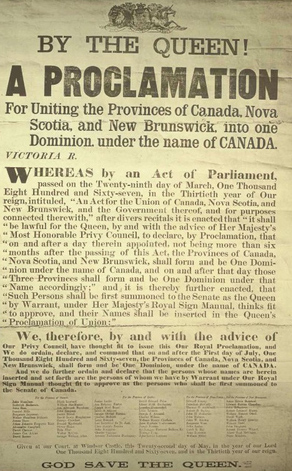 Proclamation announcing the formation of one Dominion, under the name of CANADA, 1867With the arrival of daylight on Monday 1 July 1867, the city “never looked better” to greet the thousands of visitors that were streaming into the capital from the countryside to join in the festivities. Bunting, flags, and streamers decorated public and private buildings alike along Sparks, Rideau and Sussex streets. At 7am, a lacrosse tournament between the Huron and Union Clubs commenced on Ashburnham Hill, the area east of today’s Bronson Avenue, between Lisgar Street and Laurier Avenue. At 10am, an honour guard from the Rifle Brigade took up position in front of the East Block on Parliament Hill to await the arrival of Lord Monck, the newly designated governor general of the Dominion of Canada. A half hour later, a salute from the Field Battery announced Monck’s appearance who was received by guards with presented arms. At 11am, the Queen’s proclamation was read out by Ottawa’s mayor. Dignitaries then entered the Executive Council Chamber. Monck, in plain clothes, advanced to the head of the Council table, read the Royal Instructions making him Governor General, and was sworn in by Canada’s Chief Justice. After the various oaths, the Field Battery on Major Hill’s gave another salute. The Governor General then conferred the title of Knight Commander of the Order of the Bath on John A. Macdonald for his contribution to making Confederation a reality. Several others received knighthoods of lesser orders. George-Étienne Cartier, Macdonald’s partner, was also offered a knighthood, but he refused it on the grounds it was inferior to that awarded to Macdonald. The following year, Cartier was made a baronet, a more illustrious honour, which also carried the title “Sir.”
Proclamation announcing the formation of one Dominion, under the name of CANADA, 1867With the arrival of daylight on Monday 1 July 1867, the city “never looked better” to greet the thousands of visitors that were streaming into the capital from the countryside to join in the festivities. Bunting, flags, and streamers decorated public and private buildings alike along Sparks, Rideau and Sussex streets. At 7am, a lacrosse tournament between the Huron and Union Clubs commenced on Ashburnham Hill, the area east of today’s Bronson Avenue, between Lisgar Street and Laurier Avenue. At 10am, an honour guard from the Rifle Brigade took up position in front of the East Block on Parliament Hill to await the arrival of Lord Monck, the newly designated governor general of the Dominion of Canada. A half hour later, a salute from the Field Battery announced Monck’s appearance who was received by guards with presented arms. At 11am, the Queen’s proclamation was read out by Ottawa’s mayor. Dignitaries then entered the Executive Council Chamber. Monck, in plain clothes, advanced to the head of the Council table, read the Royal Instructions making him Governor General, and was sworn in by Canada’s Chief Justice. After the various oaths, the Field Battery on Major Hill’s gave another salute. The Governor General then conferred the title of Knight Commander of the Order of the Bath on John A. Macdonald for his contribution to making Confederation a reality. Several others received knighthoods of lesser orders. George-Étienne Cartier, Macdonald’s partner, was also offered a knighthood, but he refused it on the grounds it was inferior to that awarded to Macdonald. The following year, Cartier was made a baronet, a more illustrious honour, which also carried the title “Sir.”
At noon, a massed military display was held on Parliament Hill, consisting of the Rifle Brigade, the Civil Service Rifles, the Carleton 43rd Infantry, the Ottawa Provisional Battalion of Rifles, the Ottawa Provisional Brigade of the Garrison Artillery, and the Ottawa and Victoria Cadet Corps. The show was slightly marred when the Civil Service Rifles fired a “feu de joie,” a sort of grande finale. Unfortunately, the order to “Fire” was not preceeded by the command “Remove ramrods.” A volley of ramrods was launched from Parliament Hill, across Wellington Street, to land in a hail of sparks on Sparks Street.
The military display was followed by athletic games on Major Hill. Games included the “standing” and “running” leaps, the 100-yard dash, as well as boat and canoe races. Across the city, a lunch was provided to the Carleton Infantry by Alderman Rochester at his own expense. The previous night, he had heard that the men would be arriving from the country for the parade and festivities without any refreshment organized for them. The alderman hosted the men and their families outdoors at his home, determined to rescue the “fair name of the city from the charge of want of hospitality.” More sporting events were held in New Edinburgh, including some unusual ones—a three legged race, a blindfold race, and a cricket ball throwing contest.
In the evening, another bonfire was lit, this time at Ashburnham Hill. Twenty-two cords of wood were sent up in flames. After dusk, fireworks were launched at Parliament Hill. Across the water in Hull, people picnicked as they watched the display. Music and dancing continued to the wee hours of the morning before Ottawa’s populace returned home exhausted, citizens of a new Dominion.
Sources:
Dictionary of Canadian Biography, 2014. “Cartier, Sir George-Étienne, http://www.biographi.ca/en/bio/cartier_george_etienne_10E.html.
Foster, Robert, Capt.et al, 1999. Steady the Buttons, Two by Two, Regimental History of the Governor General’s Foot Guards, Ottawa.
Story written by James Powell, the author of the blog Today in Ottawa's History.
Retired from the Bank of Canada, James is the author or co-author of three books dealing with some aspect of Canadian history. These comprise: A History of the Canadian Dollar, 2005, Bank of Canada, The Bank of Canada of James Elliott Coyne: Challenges, Confrontation and Change,” 2009, Queen’s University Press, and with Jill Moxley, Faking It! A History of Counterfeiting in Canada, 2013, General Store Publishing House, Renfrew, Ontario. James is a Director of The Historical Society of Ottawa.
The End of the Crippler
18 April 1955
 Anti-Polio Advertisement,
Anti-Polio Advertisement,
The Ottawa Journal, 2 February 1950
Thanks to vaccines we no longer live in fear of many infectious diseases that used to stalk the world killing millions each year, and maiming or crippling tens of millions more. By the early 1950s, Canadian children were routinely immunized against smallpox, diphtheria, whooping cough and tetanus. But several diseases remained to be conquered. One of the most feared was poliomyelitis, also known as infantile paralysis for its propensity to affect the young, or “the Crippler.”
The disease is caused by the poliovirus, a type of enterovirus of the family Picornaviridae. It was first isolated in 1908 by the Austrian researchers and physicians Karl Landsteiner and Erwin Popper. The virus has three serotype versions (PV1-Brunhide, PV2-Lansing and PV3-Leon). All are virulent, though PV1-Brunhide is the most common strain, and the one most associated with paralysis. Most people who come into contact with the polio virus experience no symptoms beyond a sore throat, a gastrointestinal upset, a slight fever, and a general malaise. Called “abortive polio,” this is considered a minor illness that leaves no permanent effects. A small percentage of victims experience “aseptic” polio that also involves severe neck, back and muscle pain, as well as a bad fever. In a still smaller percentage of sufferers, the polio virus attacks the central nervous system leading to muscle flaccidity, especially of the limbs, and paralysis. Depending on what part of the nervous system is affected, “paralytic” polio is classified as spinal, bulbar, and bulbospinal. In some cases, the diaphragm and chest muscles are affected. Sufferers of this form of the disease need help to breath. In 1927, two Harvard researchers invented the “iron lung,” into which paralysed patients were placed to aid their breathing mechanically. Although most were able to leave the machine after several weeks, some were confined for years, or had to use a portable breathing apparatus. Polio suffers whose limbs had become paralyzed sometimes recovered their use after a few weeks. However, some many were left permanently disabled. Two to ten per cent of people stricken with paralytic polio died. There is no cure for the disease, only prevention.
Although polio has been around for thousands of years, it didn’t use to have the fearful reputation that it had during the first half of the twentieth century. For the most part, people had acquired a natural immunity to the disease. But as living standards and hygiene improved, the incidence of the disease paradoxically increased. The natural immunity that protected people had been weakened or lost. According to Christopher Rutty, a medical historian, fears about polio, heightened by publicity, were disproportionate to the risk of catching the paralytic form of the disease. But frightened parents told their children to “regard [polio] as a fierce monster” that was “more sinister than death itself.” The fact that people at the time didn’t understand the transmission mechanism of the disease (typically faecal-oral) made it all the scarier. You didn’t know what to do to protect yourself and your family. When outbreaks occurred, often during the summer months, health officials in epidemic areas closed cinemas, playgrounds, and delayed school openings. In Ottawa, when the federal government announced in 1950 that the water from the Rideau River would be temporarily diverted to allow for repairs near its outfall into the Ottawa River, residents of Sandy Hill, fearful of polio-infected flies that might breed in exposed marshes and refuse, lobbied for the repairs to be delayed until after the summer polio season.
People stricken with polio were sent to special isolation hospitals for a minimum of seven days required by provincial law. Their families were quarantined. Ottawa’s Strathcona Isolation Hospital was one of six designated centres for the treatment of polio in Ontario. The other centres were located in Toronto, Kingston, London, Hamilton and Windsor. The Strathcona Hospital’s “territory” ran from Pembroke to Morrisburg. In 1953, the old hospital was closed when a new East Lawn Pavilion with isolation facilities was opened at the Ottawa Civic Hospital. Seventeen patients were transferred from the Strathcona facility, including one in an iron lung. Although this was a time before provincial health insurance (OHIP), the care for polio victims was paid for by the provincial government. Later, following complaints by doctors that they couldn’t submit bills to well-to-to polio patients, the government modified the rules to allow doctors to charge wealthy patients. Poor patients continued to receive free care at teaching hospitals connected to universities.
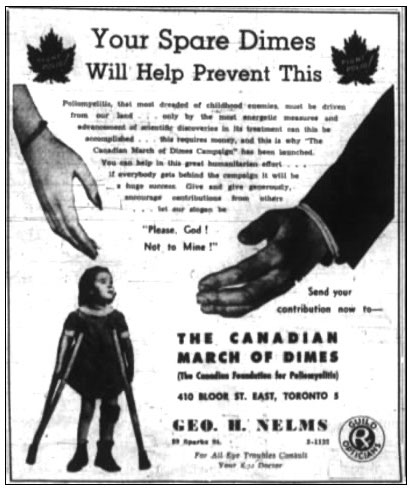 Advertisement for the Canadian March of Dimes, 1950 Campaign
Advertisement for the Canadian March of Dimes, 1950 Campaign
The Ottawa Journal, 4 February 1950Following the election of Franklin Roosevelt at President of the United States in 1933, who was himself a polio survivor, the medical profession in the United States and Canada took aim at the disease. Funding for research into the development of a vaccine was provided in the United States by the National Foundation for Infantile Paralysis that had its roots in a private anti-polio organization started by the Roosevelt family. The Foundation sponsored an annual March of Dimes campaign supported by Hollywood stars to raise money to find a cure for the disease and to care for polio victims. In Canada, a parallel organization called the Canadian Foundation for Poliomyelitis was founded in Ottawa in 1949. The Canadian Foundation held the first Canadian March of Dimes campaign the following year. Newspapers across the country carried the photograph of “Linda,” a child polio victim wearing iron leg braces. In Ottawa, twenty-five hundred blue and red checkered collection boxes were distributed in stores, banks and restaurants.
In 1953, North America experienced it worst outbreak of polio in decades. In Canada, there were 8,878 reported cases, mostly in Manitoba and Ontario, with a death rate of 3.3 persons per 100,000 population, far higher than during earlier outbreaks. Ottawa had 100 recorded cases by the end of that year’s polio season with four deaths. To help control the spread of the disease, Dr J. J. Dey, the city’s medical officer of health, advised Ottawa citizens not to drink unpasteurized milk, not to jump into water when the body was tired, and to avoid fatigue. He also told people to stay away from crowds, to keep the house free from flies, and to wash all fruits and vegetables. More usefully, he advised people to wash their hands frequently, and to boil drinking water if one had any doubts.
Fortunately, by this time, a vaccine was close at hand. In 1949, Harvard scientist Dr John Enders discovered that the polio virus could be propagated in the organs of monkeys. The following year, the Polish-born virologist Hilary Koprowski developed an experimental oral vaccine using a live but weakened virus of the PV2-Lansing variety of the disease, and successfully immunized some twenty children in New York State.
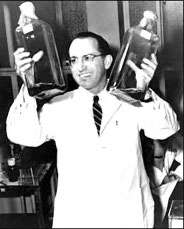 Jonas Salk at the University of Pittsburgh, 1955
Jonas Salk at the University of Pittsburgh, 1955
The Owl - University of Pittsburgh Digital Archives, WikipediaMeanwhile, at the University of Pittsburgh, Jonas Salk was working on determining the number of different strains of polioviruses and developing a vaccine using dead viruses that would be effective against all strains of the disease. Connaught Laboratories at the University of Toronto, supported by a federal grant as well as money provided by the Canadian March of Dimes, was also developing the procedure for producing industrial-size quantities of the polio virus, a necessary and vital step for the mass production of the Salk vaccine. Related work was conducted at the Institute of Microbiology and Hygiene in Montreal. Connaught later supplied much of the virus that went into making the Salk vaccine in North America as well as making the vaccine itself for the Canadian inoculation campaign.
By 1954, Salk who had safely tested his vaccine first on his family and then on 700 volunteers was ready for a large-scale test. He organized a trial involving two million children. Half received a three-shot dose of the experimental vaccine over a period of several weeks with the other half receiving placebos. Most of the children were American. But U.S. authorities offered 50,000 doses to Canada. Health departments in Alberta and Nova Scotia took up the offer and inoculated thousands of young children. In mid-April 1955, the results of the trial were announced to a packed conference room at the University of Michigan: polio had been defeated! The vaccine had been 80% effective in protecting children from the disease. The relief was palpable. Immediately, steps were taken to inoculate all children in North America starting with those in Grades 1 and 2.
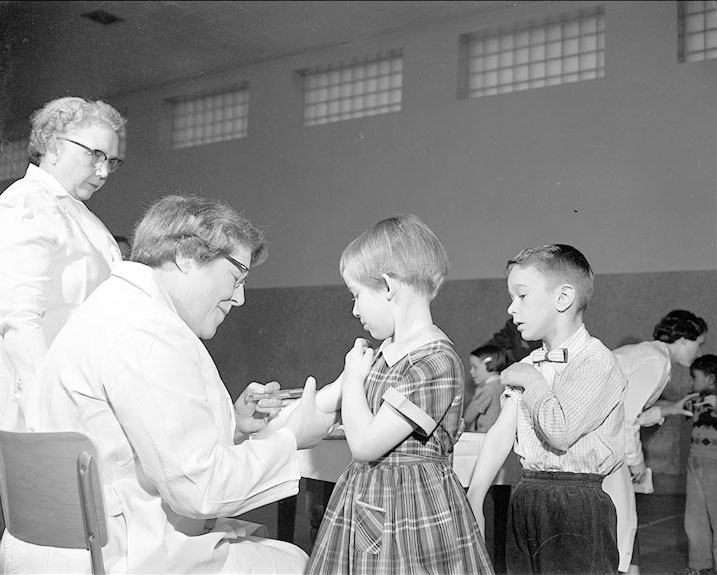 Polio shots at Elgin Street Public School, 1955
Polio shots at Elgin Street Public School, 1955
Newton Photographic Associates Ltd., City of Ottawa Archives, MG393-NP-36093-006, CA-025699In Canada, the inoculations were paid for on a 50:50 basis by the federal and provincial governments. Youngsters in Toronto and Pembroke received the first dose of the vaccine in early April even before the official announcement of Salk’s successful mass trial. The inoculation programme began in Ottawa on Monday, 18 April 1955. That morning, Grade 1 and 2 students at four public schools (Elgin, Lady Evelyn, Borden and Cambridge) and five separate schools (Ste Famille, St Patrick, St Jean Baptiste, St Anthony and Christ the King) received their first round of shots. That afternoon, five more schools were visited by teams of nurses. Children in remaining schools received their shots through the week. Parents had to sign a consent form for their children to receive the inoculation with the warning that if the children missed the first shot, they couldn’t receive the subsequent shots. Across the Ottawa River in Hull, the inoculation programme started in May with children aged two to three years since that age group had been most affected in Quebec during the 1953 epidemic.
In the midst of the roll-out of the continent-wide vaccination campaign, disaster struck. Some children in the United States came down with polio after having received their shots. Several died. The problem was traced to poor quality control at the Cutter Laboratories of Berkeley, California, one of six American vaccine manufacturers. Their vaccine contained live instead of dead viruses. According to the Journal of Pediatrics, the vaccine had been rushed. The U.S. vaccination programme was temporarily suspended despite the coming onset of the 1955 polio season. In Canada, Health Minister Paul Martin Sr faced one of the toughest decisions of his life: should the Canadian programme also be suspended as Prime Minister St Laurent wished? With all of the Canadian vaccine produced at Toronto’s Connaught Laboratories, and having full confidence in Canadian scientists and doctors, he ordered the Canadian programme to go ahead as planned. No Canadian child came down with polio as result of the vaccine.
By August 1955, the number of polio cases in Canada and the United States had dropped dramatically even though only a portion of children had been immunized. In November, Paul Martin publicly stated “I don’t think there can be any doubt that it [the vaccine] has had some effect.” By 1962, the number of reported polio cases in Canada had fallen to only 89.
In the early 1960s, the Salk vaccine was generally replaced by an oral vaccine using live but weakened viruses developed by Albert Sabin who drew on the earlier work of Hilary Koprowski. The Sabin vaccine was cheap to produce and administer and was very powerful—95 per cent effective after three doses (one for each polio strain). Polio infection rates around the world plummeted. In 1988, the World Health Organization (WHO) launched a campaign to eradicated polio from the world supported by national governments, the U.S. Centers for Disease Control and Prevention, UNICEF, Rotary International and the Bill & Melinda Gates Foundation. In 2000, the Americas were certified as polio free. In 2014, South-East Asia was certified as polio free. By 2016, the number of reported polio cases worldwide had dropped to only 37 located in Nigeria, Afghanistan and Pakistan. The WHO estimates that because of the global vaccination campaign, 16 million people walk today who otherwise would have been paralyzed. Many, many lives have also been saved. However, war and civil strife threaten this achievement. Endemic transmission of the disease continues in the three remaining polio hotspots. With vaccination efforts disrupted in these areas, the Crippler could well return.
Sources:
CBC Archives, 1993. A History of Polio in Canada, posted 7 April 2016.
Centers for Disease Control and Prevention, 2014, Poliomyelitis.
Council Bluffs Nonpareil (Iowa), 1954. “Report Results of Polio Research,” 11 April.
MedicineNet.com. 2017. Medical Definition of Abortive Polio.
Museum of Health Care at Kingston, 2017, Polio.
Ottawa Journal (The), 1949. “First Fatal Polio Case,” 20 July.
————————–, 1949. “Ottawa Cases of Polio Total 29 This Year,” 15 August.
————————–, 1949. “Foundation Plans Drive For Funds to Fight Polio,” 4 November.
————————–, 1950. “Rideau Draining To Proceed,” 10 August.
————————–, 1950. “St. Germain’s Protest Against Rideau Draining,” 15 August.
————————–, 1950. “March of Dimes For Polio Victims Starts Sunday,” 30 December.
————————–, 1953. “Ontario Announces new Policy For Treating Polio,”6 January.
————————–, 1953. “MOH Issues Statement on Polio,” 17 July.
————————–, 1953. “Lab Producing Polio Virus In Quantities,” 25 September.
————————–, 1953. “Polio Season Is Over,” 14 October.
————————–, 1953. “Hope-Filled Polio Vaccine For Million U.S. Children,” 17 November.
————————–, 1953. “New East Lawn Pavilion Opened At Civic,” 16 December
————————–, 1954. “Provinces Offered U.S. Polio Vaccine,”26 May.
————————–, 1955. “Polio Shots April 18 For Ottawa Children,” 4 March.
————————–, 1955. “Ottawa Will Start Trials of Polio Vaccine April 18,” 9 April.
————————–, 1955. “SALK CONQUERS POLIO,” 12 April.
————————–, 1955. “Salk Was So Confident of Success His Own Children Got Vaccine First,” 12 April.
————————–, 1955. “Ontario to Provide Injections for All School Children,” 12 April.
————————–, 1955. “Man’s Victory Over Polio,” 13 April.
————————–, 1955. “Duplessis Decides Quebec To Take Part In Anti-Polio Plan,” 15 April.
————————-, 1955. “First Week of Vaccine Shots Against Polio Start Monday,” 16 April.
————————–, 1955. “Salk Answers Critical Questions,” 7 June.
————————–, 1955. “Vaccine Producer Sued After boy Contracts Polio,” 24 June.
————————–, 1955. “U.S.A. ‘Polio Vaccine Mixup,’” 27 July.
————————–, 1955. “Big Drop In Deaths By Polio,” 12 August.
————————–, 1955. “U.S. Polio Fatalities Reduced Sharply,” 12 August.
————————–, 1955. “Martin Credits Salk Vaccine,” 1 November.
Rutty, Christopher, 1995. “Do Something!…Anything! Poliomyelitis in Canada, 1927-1962”.
———————-, 1999. The Middle-Class Plague: Epidemic Polio and the Canadian State, 1936-37.
Smithsonian, National Museum of American History, 2017. The Iron Lung and Other Equipment.
World Health Organization, 2017. Poliomyeliti.
Story written by James Powell, the author of the blog Today in Ottawa's History.
Captains of the Clouds
16 July 1941
It was mid-summer 1941. Britain, Canada and the rest of the Commonwealth had been at war with Nazi Germany for almost two years. Although the Royal Air Force had fought off the German Luftwaffe in the Battle of Britain, the war news was grim. That June, German forces had launched Operation Barbarossa, the invasion of the Soviet Union. By mid-July, Russian forces, their officer corps decimated by Stalin’s purges, were in rapid retreat falling back towards Kiev and Moscow.
On the other side of the globe, shooting of a very different sort got underway in Canada. A crew from Warner Brothers, the motion picture studio, arrived in Ottawa, their six-week mission to film Captains of the Clouds, the first ever Hollywood movie shot entirely in Canada. The movie was the story of brash, Canadian bush pilots joining the British Commonwealth Air Training Plan (BCATP) after hearing Churchill’s historic “We shall fight them on the beaches” speech following Dunkirk. Deemed too old for combat missions, they become instructors, but later are called upon to ferry bombers to Britain.
The BCATP was the largest-ever aircraft instructional programme, training Canadian, British, Australian and New Zealand servicemen as well as men from other Commonwealth and foreign countries, including the United States. From when it commenced operations in early 1940 until it was wound down in late 1944, the Plan trained 131,553 pilots and crewmen, over half of whom (72,835) were Canadian. Costing $2.2 billion of which Canada paid $1.6 billion (equivalent to about $25 billion in today’s money), the Plan was Canada’s single-most important contribution to the Allied war effort. Recall also that Canada’s population at the time was only 12 million, a third of what it is currently.
The movie, which was directed by Michael Curtiz, starred James Cagney who was at the peak of his skills and at the height of his popularity. It was Cagney’s first movie to be filmed in Technicolor. Co-starring were Dennis Morgan, Alan Hale Senior, and George Tobias as his bush pilot pals, and Brenda Marshall as the love interest. The movie was filmed in co-operation with the Royal Canadian Air Force (RCAF). Air Marshal “Billy” Bishop played a cameo role as himself in a graduation, or “wings,” ceremony. Bishop was an ace Canadian pilot from the First World War, and a recipient of the Victory Cross. In 1941, he was the Director of the RCAF and in charge of recruitment. Hundreds of RCAF servicemen and women also appeared in the film as bit players and extras. Much of the movie was filmed at Uplands Airport (now the Macdonald-Cartier International Airport) in Ottawa, with the bush scenes filmed in the North Bay area at Trout Lake and Jumping Caribou Lake. Flying scenes were also filmed at air stations located in Trenton, Dartmouth, Jarvis and Mountain View.
Cagney arrived in Ottawa dressed in a white suit in the wee hours of the Sunday morning before the beginning of the shoot, scheduled for Wednesday, 16 July 1941 at Uplands Airport, site of the No. 2 Service Flying Training School. He arrived by train from his Martha’s Vineyard farm, and stayed in a suite on the second floor of the Château Laurier Hotel, accompanied by his brother William who was a producer on the movie. Initially reluctant to star in the movie, Carney apparently made his participation contingent on Warner Brothers hiring his brother. Despite the early hour of his arrival, there was a crowd of female fans and a large press contingent there to greet him in the lobby. The Ottawa Evening Citizen reported that Cagney was not the “tough guy of the screen” but rather a “mild spoken, quiet, mannerly, young fellow.”
The first scene filmed on the Wednesday morning was the “wings” ceremony starring Air Marshall Billy Bishop, along with Wing Commander, W.R. MacBrien, the chief instructor at Uplands, Group Captain W.A. Curtis, the airport’s commanding officer, and Flight Lieutenants Harry Wood and Paul Rodier. Behind the scenes, the Warner film technicians wore sky-blue overalls to identify themselves as the film crew so they wouldn’t be confused with possible “fifth columnists” and saboteurs. Although Bishop performed well—Cagney called him “a natural”— the shoot was a nightmare requiring many takes owing in part to bad weather, malfunctioning equipment and the need to coordinate the ground action with complex aerial manoeuvres. It was well worth the effort, however. The scene of the airmen receiving their wings set against the backdrop of bright yellow Harvard trainers and camouflaged bombers with the service flags of Canada, Britain and Australia flying overhead provided a stirring spectacle, especially when you remember that these weren’t actors but real, wartime servicemen who would shortly be thrown into combat.
Generally speaking, the film was difficult to make from other perspectives. The American movie crew was unused to filming in wartime conditions. America was still a neutral country when Captains was made, five months before the Japanese attack on Pearl Harbor. Ottawa was choc-a-block full of servicemen and women. Consequently, living space was at a premium. While Cagney and the other stars were put up at the Château Laurier, the rest of the crew slept in the barracks at the Uplands flight school, eating service food. They were also far from the amenities of Ottawa. Reportedly, the crew almost struck over unsatisfactory conditions. Working in the bush also proved challenging. Cagney, who did some of his own stunts, suffered a concussion that delayed filming for several days as he recovered. As well, Sol Polito, the cinematographer, who initially had trouble getting into Canada owing to his Italian birth, reportedly suffered a heart attack while the film was being made.
Cagney, the other stars, and the Warner Brothers’ crew stayed in Ottawa for ten days. For Ottawa residents, the filming provided a much needed morale boost and a distraction from wartime privations and worries. The Hollywood stars were mobbed in the streets and at their hotel. On one occasion, Alan Hale had to take refuge in a shop when spotted on Sparks Street by admirers. Dennis Morgan, described by a journalist as having “the shoulders of a football player, voice of an opera star, and the face of a matinee idol,” received hundreds of letters, many of the “mash” variety, from adoring female Ottawa fans. Small boys staked out the hotel in wait for their heroes. Four enterprising young teenagers, brothers Frankie and Buddy Russell and their two friends Jim McNally and Bob Vaive managed to evade security and knocked on Cagney’s hotel room door. Cagney cheerfully signed autographs for them.
The most serious occurrence took place on the Thursday night, the day after the initial shoot at Uplands Airport. Cagney and the other stars had agreed to perform for service people, wives and sweethearts at the Rockcliffe air station. When the news got out, more than a thousand fans stormed the Château Laurier to catch a glimpse of the stars as they left for their performance. Cagney was tackled by near hysterical girls who grabbed his arms, clutched at his clothing and ruffled his hair. Alan Hale and Dennis Morgan also had a difficult time getting through the crowds. It was only with the help of a security team of soldiers who held back the straining fans that filled the hotel’s rotunda that the celebrities were able to get to their automobile. The Citizen described the spectacle as resembling “a mob scene from one of the bigger Hollywood epics.” The stars were good natured about it, but arrived a half hour late for their performance.
For the servicemen, it was worth the wait. With Cagney acting as the impromptu master of ceremonies, the Warner Brothers’ gang put on a lively vaudeville show, complete with dancers and singers. Dennis Morgan sang “Annie Laurie,” accompanied by Miss Jean McGuire of Ottawa on the piano, followed by an encore of “A Little Bit of Heaven.” George Tobias and Alan Hale told jokes. Apparently, Hale had the audience rolling in the aisles with laughter. At the end of the evening, the stars acknowledged the Dominion’s war effort saying “For what you people are doing, we salute you.”
During their stay in Ottawa, the stars and members of the Warner Brothers technical crew also played two ball games with servicemen. The Hollywood stars lost the first softball game 8-6 at Rockcliffe air station. Claiming they knew nothing about softball, the Hollywood stars asked for a rematch hardball game. This second game was played at Landsdowne Park in front of 2,000 Ottawa fans; tickets were 25 cents each, with the proceeds going to the Red Cross, the RCAF Benevolent Fund and towards the construction of a sports field at No. 2 Flying School at Uplands. For the Hollywood visitors, James Cagney played catcher, Dennis Morgan played first base, and George Tobias pitched. Other members of the Warner Brothers technical and engineering team rounded out the team. Alan Hale was umpire. Hale said “I asked to be umpire because I am prejudiced. I want to see the air force win.” Ottawa Mayor Stanley Lewis threw the first pitch. The visitors won the five-inning game by a close 5-4 score. The winning pitcher was Dick Emmons, the Warner Brothers’ grip who relieved Tobias after the first inning. Douglas Heiman was the losing RCAF pitcher. Cagney played one inning, while Hale refereed for two. Dennis Morgan played the entire game.
After ten days of shooting, the Hollywood stars and the rest of the Warner team left Ottawa to go to their next film location at North Bay. Several hundred fans were at the Château to see their idols leave. As a birthday gift for Cagney, who turned 42 while in Ottawa, the “Upland boys” presented him with a silver identification tag engraved with his name and movie rank. It read “Flying Officer James Cagney, Captain of the Clouds, 1941.”
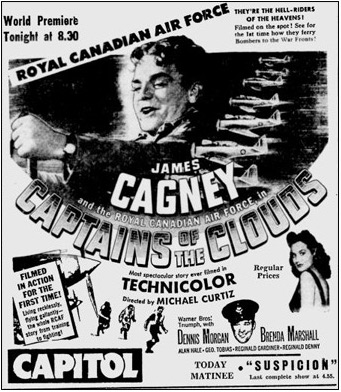 Advertisement for the World Premiere of "Captains of the Clouds", The Capitol Theatre, Ottawa. The Evening Citizen, 12 February 1942The movie was released on 12 February 1942, with premieres in Ottawa, Toronto, Vancouver, New York, London, and Cairo. The Ottawa premiere was held in the Capitol Theatre located at the corner of Bank and Queen Streets. The cinema was filled to capacity. Among the official attendees was Lieutenant General Andrew McNaughton who commanded the Canadian Corps. Before the movie started, RCAF service men and a trumpet and drum band from Uplands paraded to the cinema. On the Capitol stage, the band of the Royal Canadian Mounted Police played a programme of patriotic, marching tunes. The Capitol’s management bought Victory bonds with the proceeds of the first week’s shows.
Advertisement for the World Premiere of "Captains of the Clouds", The Capitol Theatre, Ottawa. The Evening Citizen, 12 February 1942The movie was released on 12 February 1942, with premieres in Ottawa, Toronto, Vancouver, New York, London, and Cairo. The Ottawa premiere was held in the Capitol Theatre located at the corner of Bank and Queen Streets. The cinema was filled to capacity. Among the official attendees was Lieutenant General Andrew McNaughton who commanded the Canadian Corps. Before the movie started, RCAF service men and a trumpet and drum band from Uplands paraded to the cinema. On the Capitol stage, the band of the Royal Canadian Mounted Police played a programme of patriotic, marching tunes. The Capitol’s management bought Victory bonds with the proceeds of the first week’s shows.
The same night, two hundred RCAF airmen attended the New York premiere at the Strand Theatre. The airmen were feted on their 36-hour stay in New York at the Waldorf hotel. For the showing of the film, each airman was escorted by a John Powers model. Also in attendance was Leighton McCarthy, the Canadian Minister to the United States.
While the aerial shots were applauded and the film garnered two Academy Award nominations, one for best colour cinematography, and the other for colour interior decoration, film critics gave the movie mixed reviews. The New York Times described the first half as a “routine, he-man fable,” but said the documentary-like, second half took on “some consequence.” The Times critic added that “he had the odd feeling throughout the second half of the film that a company of Hollywood actors, fugitive from a previous picture, had got loose amid the serious activities and flashing planes of the R.C.A.F.” Unsurprisingly, the movie was a big hit with Ottawa fans. The Citizen called it “breathtaking in its loveliness.” The paper gushed “There can be no doubt that “Captains of the Clouds” is without prejudice in any way, the finest aviation picture ever produced.”
Released only weeks after the United States’ entry into the war, Captains of the Clouds was a propaganda success for the RCAF. It also earned its place in cinematographic history as a forerunner of later combat movies. One modern critic called the film the Top Gun of its age. While IMDb gives Captains of the Clouds a middling 6.5 rating, it’s worth seeing if for no other reason than the spectacular aerial shots and the glimpses of Uplands Airport and downtown Ottawa as they were seventy-five years ago.
Sources:
Arnold, Jeremy, 2016. “Captains of the Clouds,” Turner Classic Films.
Evening Citizen (The), 1941. “Jimmy Cagney Arrives To Play Lead in Film,” 14 July.
————————-, 1941. Four Ottawa Boys ‘Blitz’ Jim Cagney For Autograph,” 15 July.
————————-, 1941. “Canadian Flying Ace Takes Speaking Role In Picture Filmed At Upland Airport,” 16 July.
————————-, 1941. “Movie Stars Will Entertain Airmen At Party Tonight,” 17 July.
————————-, 1941. “Soldiers Battle Crowd And Rescue Movie Stars, 18 July.
————————-, 1941. “Film Stars Due To Play Airmen,” 21 July.
————————-, 1941. “Fun Is Promised Tonight In Special Softball Game,” 23 July.
————————-, 1941. “Film Stars Turn Back Airmen In Benefit Softball Game,” 24 July.
————————-, 1942. “Captains of the Clouds Rated No. 1 Flying Film,” 13 February.
————————-, 1942. “Canadian Airmen Royally Feted on Manhattan Visit, 13 February.
Hatch, F.J., 1983. Aerodrome of Democracy: Canada and the British Commonwealth Air Training Plan, 1939-1945, Department of National Defence, Directorate of History, Monograph Series No. 1.
IMDb, 2016. Captains of the Clouds.
New York, Times (The), 1942. “Captains of the Clouds, Heroic Film About The Royal Canadian Air Force and Starring James Cagney, Arrives At The Strand,” 13 February.
Taylor, Chris, 2016. “Inflight Movie: Captains of the Clouds (1942),” Taylor Empire Airways.
Youtube, 2011. Captain of the Clouds, trailer.
Story written by James Powell, the author of the blog Today in Ottawa's History.
Retired from the Bank of Canada, James is the author or co-author of three books dealing with some aspect of Canadian history. These comprise: A History of the Canadian Dollar, 2005, Bank of Canada, The Bank of Canada of James Elliott Coyne: Challenges, Confrontation and Change,” 2009, Queen’s University Press, and with Jill Moxley, Faking It! A History of Counterfeiting in Canada, 2013, General Store Publishing House, Renfrew, Ontario. James is a Director of The Historical Society of Ottawa.
Lights Out!
14 August 2003
It was a typical mid-August summer day in the nation’s capital—hot and muggy. Earlier that Thursday, the thermometer had topped 31 degrees Celsius. By mid-afternoon, the usual early rush hour of public servants was in full swing, with cars pouring out of the city, many heading north towards cottage country in the Gatineau hills to get some relief from the heat and humidity. But the evening was going to be anything but normal. Without warning at 4:11pm, street lights failed, air conditioners stopped, and computers went dark across Ottawa.
It took a while for the enormity of the situation to be fully appreciated. Electric power had failed across eight U.S. states and much of Ontario, reminiscent of the blackout that had plunged much of the U.S. North Eastern seaboard and Ontario into darkness in 1965. In the course of a few minutes, some one hundred electrical generating plants, including 22 nuclear power plants, shut down. More than 50 million people were left without power living in an area of roughly 24,000 square kilometres.
Less than two years following the 9/11 attacks in the United States, people’s first thoughts were of terrorism. While this possibility was quickly ruled out, politicians on both sides of the international border were quick to lay blame on others. Prime Minister Chrétien’s office suggested that a lightening strike at an upstate New York power station was responsible for the cascading failure across the international electrical grid. New York power authorities denied this, claiming that the problem originated outside of the United States, i.e. Canada. New York Governor Pataki also pointed the finger at Canada, while Canadian Defence Minister John McCallum blamed a failure at a Pennsylvania nuclear power plan. None were right.
The following year, the inelegantly named U.S.-Canada Power System Outage Task Force concluded that the cascading failure originated in Ohio. High temperatures and a corresponding high demand for power had caused overloaded transmission wires to heat up and sag, touching unpruned trees. This in turn caused a generating plant in Eastlake, Ohio to shut down, putting an intolerable strain onto other transmission lines, which in turn tripped breakers shutting down power elsewhere as successive plants were overloaded. The outage could have been easily managed and the resulting blackout contained locally had there not been a computer software bug in the alarm system at FirstEnergy Corporation, the responsible Ohio-based power authority, that did not go off in time to warn system operators.
While the immediate cause of the blackout was high tension wires touching trees in Ohio, the Task Force highlighted a number of systemic failures which contributed to the power grid failure. Importantly, the Task Force identified shortcomings at FirstEnergy Corporation. These included a lack of understanding about the deteriorating conditions of its system, and a failure to maintain adequately its transmission right-of-ways. A number of minor violations of existing regulations were also noted. More generally, the Task Force concluded that the North American Electric Reliability Corporation (NERC), the not-for-profit agency tasked with overseeing North American power production, did not have the authority to develop or require compliance of strong reliability standards by member utilities. In the absence of such reliability standards, no financial penalty was levied on FirstEnergy for the power blackout.
Back in Ottawa, life carried on more or less as normal that evening. With street lights dead, all intersections became four-way stops. Rush-hour traffic moved, albeit slowly, with gridlock avoided in some cases by pedestrians who took over traffic control. Despite the muggy heat and fraying tempers, the commute home was described as “surprisingly civil” by a police official. Long delays in OC Transpo service led bus riders to hoof it; many receiving rides from passing private cars. With all flights at the MacDonald-Cartier International airport grounded, stranded passengers either dossed down at the terminal or found rooms in nearby hotels.
There were some also serious problems that night. There were apparently 22 cases of looting in the city, as well as an armed robbery at a Sparks Street jewellery store. There were also three fires, one of which claimed the life of a teenaged boy. Restaurants were also negatively affected by the loss of refrigeration; some gave away melting ice cream to passersby. On the upside, the blackout provided the perfect excuse for impromptu street parties. As well, the clear sky that night was a great opportunity to view the stars, undimmed by light pollution—as long as you looked south. The lights of Hull and Gatineau remained on as Quebec’s power grid was unaffected by the black-out. They provided a surreal backdrop to Mayor Bob Chiarelli’s televised address to the city in offices in front of Parliament Hill to explain why the city was in darkness.
By the next morning, the lights began to slowly come back on. The state of emergency announced the previous night by Ontario’s premier, Ernie Eaves, was eased. Within 24-48 hours, power had been largely restored. But the system remained unstable and unbalanced; you can’t restart power plants with a flip of a switch. Government offices and many businesses remained closed for up to week before the situation returned to normal. Besides holidays for unessential staff, the blackout provided a perfect test of backup systems that had been established following the September 2001 terrorist attacks. In total, it is estimated that the blackout cost Ontario 18.9 million in lost employment hours, with manufacturing shipments falling $2.3 billion.
Could it happen again? On the positive side, there have been major improvements to the reliability of the international grid since 2003. Significant investments have been made on both sides of the border which have made the grid more robust. As well, the NERC has established and now enforces reliability standards with electricity producers, and has the power to levy significant fines in the event of non-compliance. Grid operators also employ simulators to model a wide range of possible scenarios, and how to respond to various catastrophic situations. The development of smart grids and distributed power production by lots of small producers may have also reduced the risk of major blackouts. However, it is impossible to plan for all eventualities. Human error, computer viruses and terrorism remain risks. So, keep that flashlight handy.
Sources:
CBC News, 2013. “Ottawa reflects on decade after massive blackout,” 14 August.
——————, 2013. “Blackout ten years on: How smart grids help blackout-proof the power game,” 14 August 2013.
NERC, 2013. NERC Board Approves 2014 Budget, ESCC Charter and Adopts 3 Reliability Standards, 16 August 2013:.
The Ottawa Citizen, 2013. “In Blacked out Ottawa, life went on (almost) as usual,” 14 August.
The Toronto Star, 2013. “Blackout 2003: How Ontario went Dark,” 14 August.
U.S.-Canada Power System Power Outage Task Force, 2004. Final Report on the August 14, 2003 Blackout in the United States and Canada: Causes and Recommendations, April.
Wikipedia: Northeast Blackout of 2003.
Story written by James Powell, the author of the blog Today in Ottawa's History.
Retired from the Bank of Canada, James Powell is the author or co-author of three books dealing with some aspect of Canadian history. These comprise: A History of the Canadian Dollar, 2005, Bank of Canada, The Bank of Canada of James Elliott Coyne: Challenges, Confrontation and Change,” 2009, Queen’s University Press, and with Jill Moxley, Faking It! A History of Counterfeiting in Canada, 2013, General Store Publishing House, Renfrew, Ontario. James is a Director of The Historical Society of Ottawa.
Queen Victoria’s Diamond Jubilee
22 June 1897
Queen Victoria was our longest reigning monarch until her record of 63 years, seven months was eclipsed by that of Queen Elizabeth II in 2015. When Victoria celebrated her Diamond Jubilee, marking 60 years on the throne in 1897, the British went wild with joy. They had lots to celebrate. During her reign, Britain had been transformed. The nation had undergone an industrial revolution that had sharply raised national income. Electricity illuminated city streets and was beginning to light British homes. The telephone and the telegraph provided rapid communications, while railways and fast steamships moved people and goods effectively and efficiently around a British Empire that covered a sixth of the globe. This is not to say Victoria personally had much to do with all this, but she was the symbol of British achievement. There were clouds on the horizon, however. Germany and the United States were both challenging Britain on multiple fronts. And trouble was brewing in South Africa with the Boers. But in that glorious summer of 1897, Britain was on top of the world, economically, militarily, and politically. The Queen’s 60th anniversary on the throne was a good opportunity to celebrate. Although the actual anniversary date of her accession was Sunday, 20th June 1897, the official celebrations took place on Tuesday, 22nd June—declared an Empire-wide holiday.
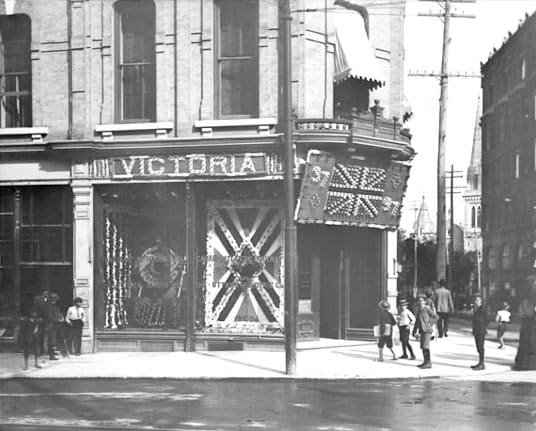 SE Corner of Sparks & Elgin, Front entrance of the office of the Canada Atlantic Railway Company
SE Corner of Sparks & Elgin, Front entrance of the office of the Canada Atlantic Railway Company
Topley Studio, Library and Archives Canada, PA-027878In Ottawa, preparations for the celebrations began weeks before the big day. The Capital bedecked itself in festoons of red, white and blue bunting and flags. For the patriotically minded, John Murphy & Co. sold bunting at 5 1/2 cents per yard. Large flags went for 15 cents, while a bust of the Queen could be had for 39 cents, marked down from 75 cents. For those who could afford it and were connect to the grid, electric lights were the way to go. Thousands of electric lights were strung along streets, and on store fronts at a cost of 10 cents per light, and 25 cents per light installation. So many were the lights, they strained the capacity of the Ottawa Electric Company. On Parliament Hill, the Centre Block was completely illuminated. Above the main entranceway into the Victoria Tower was a massive circle of lights surmounted by a crown, enclosing the letters “V.R.I.” for Victoria Regina Imperatrix. On the top floor of the far western tower was a crown surrounded by a circle of lights. In the three small windows beneath was “1837.” This was matched by a circle of lights around a star with “1897” in the three small windows in the second western tower. Between the two dates were the words “Dieu sauve la Reine.” This decorative motif was repeated on the eastern side of the building but with the words “God save the Queen.”
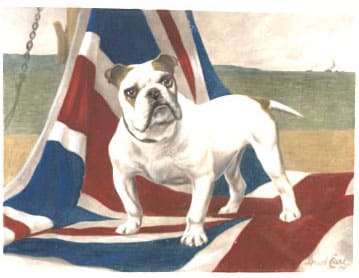 Dimboola, the mastiff, by Maud Earl "What we have, we'll hold
Dimboola, the mastiff, by Maud Earl "What we have, we'll hold
Canadian War Museum, 1896City streets were also illuminated. According to the Journal newspaper, “Sparks Street never looked gayer.” Flags lined both sides of the thoroughfare. Coloured streamers crossed the street from Sappers’ bridge to the Upper Town market (Lyon Street).” A “myriad” of lights lit up the street “like stars along the milky way.” The best display was reportedly at the office of the Canada Atlantic Railway at the corner of Sparks and Elgin Streets. Picked out in red, white and blue lights was a Union Jack over the front door, with the figures “37” and “97” on either side. The lights switched on and off giving the impression that the flag was waving. The words “Victoria” and “Regina” were written in electric lights at the top of the store windows on either side of the main door. In the Sparks Street window was the front of a railway engine, its cowcatcher covered with lights. On the front of the boiler were the dates 1837 and 1897 below the letters “V.R.” Next to the engine was the Queen’s portrait in a diamond-shaped frame surrounded by lights.
Wilson & Sons Art Store on Sparks Street displayed a striking patriotic print of a painting by Maud Earl of the mastiff champion “Dimboola” standing defiantly on a Union Jack with war ships in the background. The inspiration for the painting was a speech by Joseph Chamberlain, a popular British imperialist, in the House of Common in London who said “What we have we’ll hold.” The print was later purchased by Colonel Sherwood and given to the officers’ mess of the 43rd Battalion stationed in Ottawa.
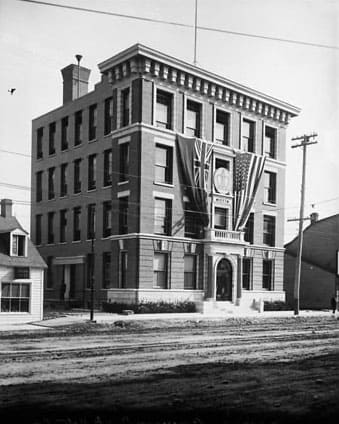 Queen Victoria Jubilee American Bank Note Company
Queen Victoria Jubilee American Bank Note Company
Topley Studio LAC-PA-027912The bank buildings that lined the south side of Wellington Street were also decorated in electric lights. Most chose variants of “V.R.I.,” crowns, or stars. The Union Bank had both, adding the words “The Queen God Bless Her” for good measure. The Quebec Bank was a bit more original opting for a diamond surrounding the figure “60.” The American Bank Note Company was decorated by two large flags, one British and one America on either side of an electrically-lit crown. On Elgin Street, Ottawa’s city hall was decorated with a large crown inside a circle of electric lights as well as “chromos” (colour prints) of the Queen and various British emblems, with flags, colourful bunting and festoons of lights.
British American Bank Note Company, Wellington Street, decorated for Queen Victoria’s Jubilee, June 1897. Note that the street is not asphalted. Topley Studio, Library and Archives Canada, PA-027912.
Jubilee celebrations began on the Saturday with the release of Canada’s first issue of commemorative stamps–two portraits of the Queen, one as a teenager on her accession and the other as an elderly woman. There was a huge crush of people at the Ottawa post office all trying to buy stamps as souvenirs. Many went home disappointed as the supply was very limited, especially of the one half and six cent stamps. All were gone within an hour of the post office’s opening. Reportedly, premiums were being paid by people to acquire them.
On the Sunday, the actual anniversary of Queen Victoria’s accession, churches across the city held Thanksgiving Services. That afternoon at 4pm, the Sons of the Empire sang God Save the Queen. Orders had gone out to all the lodges around the Empire to sing at that hour, starting in Fiji, “the exact antipodes to England.” Afterwards, the Sons of the Empire and other societies, including the Caledonian Society and the Boys’ Brigade, marched in a parade through Ottawa streets.
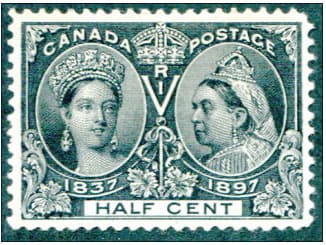 Queen Victoria 1/2 cent Canadian postage stamp, Canadian Commemorative Issue for Queen Victoria's Diamond Jubilee, 1987On that Sunday, the Evening Journal ran a fascinating story on the reminiscences of old timers looking back at Queen Victoria’s accession to the Crown in 1837. Captain Thomas Jones, who arrived in Bytown in 1827 as a young boy, recounted that the news reach the community six or seven weeks after the event. At that time, Bytown boasted a population of just 2,000 souls—300-400 in Upper Town and 1,600-1,800 in Lower Town—apart from the “canallers” who lived in mud and wooden shanties along the canal. Jones recalled that some soldiers would have preferred her uncle, the Duke of Cumberland, to have become the Sovereign. They expressed “strong feelings against a woman, especially a young one,” assuming the Crown. Paradoxically, he added that “loyalty was always prominent.” Rev. John Gourley of Nepean Street said Bytown residents were “reaping the wheat and saving the last of the hay” when the news finally reached them. In church, people were still praying for health of the old king, and the royal family, including Princess Victoria. The news, when it finally came, was, however, overshadowed by the Rebellion of 1836-37. But “there was not a man in the land so rebellious as not to pray sincerely for the best health, longest peaceful reign, and the greatest prosperity.” He added that in 1837 the city centre was a duck pond, Bank Street was a cedar and ash swale, and the garrison just a few stone huts. Another senior citizen, John Joyce of Henry Street, recalled that a celebratory bonfire had been lit at the corner of Nicholas and Rideau Streets, and everybody was there. “Cheer after cheer went up in honour of the youthful Queen.”
Queen Victoria 1/2 cent Canadian postage stamp, Canadian Commemorative Issue for Queen Victoria's Diamond Jubilee, 1987On that Sunday, the Evening Journal ran a fascinating story on the reminiscences of old timers looking back at Queen Victoria’s accession to the Crown in 1837. Captain Thomas Jones, who arrived in Bytown in 1827 as a young boy, recounted that the news reach the community six or seven weeks after the event. At that time, Bytown boasted a population of just 2,000 souls—300-400 in Upper Town and 1,600-1,800 in Lower Town—apart from the “canallers” who lived in mud and wooden shanties along the canal. Jones recalled that some soldiers would have preferred her uncle, the Duke of Cumberland, to have become the Sovereign. They expressed “strong feelings against a woman, especially a young one,” assuming the Crown. Paradoxically, he added that “loyalty was always prominent.” Rev. John Gourley of Nepean Street said Bytown residents were “reaping the wheat and saving the last of the hay” when the news finally reached them. In church, people were still praying for health of the old king, and the royal family, including Princess Victoria. The news, when it finally came, was, however, overshadowed by the Rebellion of 1836-37. But “there was not a man in the land so rebellious as not to pray sincerely for the best health, longest peaceful reign, and the greatest prosperity.” He added that in 1837 the city centre was a duck pond, Bank Street was a cedar and ash swale, and the garrison just a few stone huts. Another senior citizen, John Joyce of Henry Street, recalled that a celebratory bonfire had been lit at the corner of Nicholas and Rideau Streets, and everybody was there. “Cheer after cheer went up in honour of the youthful Queen.”
Tuesday, 22 June 1897 dawned to perfect weather—bright sunshine, warm and a refreshing breeze, though later there were some complaints of dust kicked up from unwatered city streets. (Most streets were still unasphalted.) At 7.59am, the bells at St. Patrick’s church began ringing, followed by those at St. George’s, and the Basilica. Within moments, thirty churches had joined in the peel. The whistle at E.B. Eddy’s then began to blow, and was shortly joined by factory and shop whistles across the city, followed locomotive horns at the train depots. The church bells continued at intervals for the next half hour, while the E.B. Eddy whistle went continuous for nine minutes. Adding to the cacophony was the barking of dogs and the shouting and cheering of Ottawa residents standing in front of their homes waving flags.
At 9am, a 1,000-man parade of the St. Jean Baptiste Society set out on a procession through the streets of Ottawa after a celebratory Mass at the Basilica to demonstrate “what loyalty exists in the hearts of French Canadians towards Her Majesty the Queen.” At the head of the procession was Monsieur F. Laroque, the grand marshal of the Society as well as the grand marshals of the Artisans. The Saint Anne band played marching tunes while various other societies that had joined the parade carried banners and flags.
Later in the day, 8,000 children—6,000 from Ottawa and 2,000 from Hull—dressed in white or pale blue with red, white and blue trimmings, waving tiny Union Jacks, assembled on Parliament Hill. The Upper Town children had walked from Central West School with each class headed by their teacher, and each school headed by their principal. Lower Town children began their march to the Hill from the Byward Market. Separate school children were led by grey-gowned nuns. The children took their position on either side of the central walkway in front of the Centre Block where a large decorated stage had been erected. The dignitaries present for the event included the Governor General, Lord Aberdeen and senior Cabinet ministers, and civic leaders. Wilfrid Laurier, the Prime Minister, was absent. He was in London participating in the Queen’s parade as a guest of honour. He was knighted the same day.
Lord Aberdeen, wearing the uniform of a Lord Lieutenant with the star of a baronet of Nova Scotia and other honours pinned to his chest, spoke to the children and a crowd of 25,000 people about the Queen’s life of service, her dedication to duty, and the example she set for others. He also read out loud the Queen’s blessings and thanks to “my beloved people” in Canada, that he had received earlier that morning. Following a tremendous cheer from the crowd, he read out his response saying that Her Majesty’s “most gracious and touching message” will “stir afresh hearts already full.” To provide a lasting tribute to the Queen, Lord Aberdeen announced the establishment of the Victorian Order of Nurses to be dedicated to help and relief of the sick and lonely.
Following other speeches, Professor Birch of the College of Music stood on a chair and raised his baton—the signal for the Bandmaster McGillicuddy of the 43rd Battalion to sound the key for the National Anthem. Upon the third beat, the massed choir of children from Ottawa and Hull began to sing “God Save the Queen.” After singing the anthem twice through, “three cheers” were given to the Queen and Lord Aberdeen.
Later at Cartier Square by the Drill Hall, the 43rd Battalion held an inspection and completed complicated military practices, including sword drill, pursuit exercises on horseback, and independent firing drill. The battalion, accompanied by a company of Fenian Raid veterans, also did a “march past.” Crowds of onlookers stood five and six persons deep around the Square to witness the military manoeuvres. The Journal commented that “the main part of the rising generation occupied reserved seats on the trees and telephone poles.” Lord Aberdeen presented the Royal Humane Society medal to Pte Douglas Lyon of the 43rd Battalion for bravery in attempting to save the lives of two young boys who drowned after falling through the ice while skating on the Rideau Canal at the end of November the previous year. This was followed by a 21-gun Royal Salute by the Ottawa Field Battery from Nepean Point.
The afternoon of Jubilee Day was taken up by sporting events at Lansdowne Park, including a lacrosse match between the Capitals and the Shamrocks. The Capitals emerged victorious 6-1. After sundown, Ottawa residents and visitors strolled around downtown streets to admire the illuminated buildings. There was, however, a lighting glitch on Parliament Hill. When the lights were switched on shortly before 9pm, a portion stayed dim. Fortunately, the problem was quickly rectified. Musical entertainment was provided on the big stage in front of the Centre Block. Madame Arcand opened, singing a solo of The Land of the Maple. She was joined by a 300-voice choir. Other patriotic songs sung by other vocalists included: Hearts of Oak, British Tailors’ Toast and, of course, Rule Britannia. Mr. Choquette MP followed with Dieu Brigadier in French. A Highland Pipes band also played a number of tunes, followed by Scottish dances.
At 10pm, the fireworks began at Cartier Square. Paper balloons were sent up into the sky with multi-coloured lights attached to them. In addition to the usual rockets, and “whiz bang bombs” that exploded in red, white, blue and green stars, there were a number of set pieces on the ground. This included a triple wheel that changed colour, Prince of Wales feathers with red fire coming out of the top of each feather, and a diamond jewel. The piece de resistance was a double head of Queen Victoria thirty feet long and 20 feet high with the motto “Our Queen of 60 years, 1837-1897” at the base. The double head, which constantly changed colour, remained lit for five minutes as the band struck up God Save the Queen. For the grand finale, the words “Good night” were spelt out while sky fifty rockets exploded overhead.
Queen Victoria died on 22 January 1901.
Sources:
Evening Journal, 1896. “Sank To Death Together,” 1 December.
——————–, 1897, “John Murphy & Co.” 18 June.
——————–, 1897. “Will Follow The Beat of The Drum,” 19 June.
——————–, 1897. “Oh! Did You Get One?” 19 June.
——————–, 1897. “With United Vocies,” 19 June.
———————-, 1897. “Remember the Day the Queen Was Crowned,” 21 June.
———————-, 1897. “Pulpit Tributes to the Queen,” 21 June.
———————-, 1897. “The Jubilee Has Begun,” 21 June.
———————-, 1897. “The Capital Celebrates,” 23 June.
———————-, 1897. “City Illuminations,” 23 June.
———————-, 1897. “The Fireworks,” 23 June.
———————-, 1897. “Ten Thousand Lights,” 24 June.
———————-, 1897. “An Impressive Potrait,” 24 June.
Ottawa Citizen, 1897. “A Striking Picture,” 22 June.
——————, 1897. “god Save The Queen,” 22 June.
VON Canada, 2018, About VON.
Story written by James Powell, the author of the blog Today in Ottawa's History
Retired from the Bank of Canada, James is the author or co-author of three books dealing with some aspect of Canadian history. These comprise: A History of the Canadian Dollar, 2005, Bank of Canada, The Bank of Canada of James Elliott Coyne: Challenges, Confrontation and Change,” 2009, Queen’s University Press, and with Jill Moxley, Faking It! A History of Counterfeiting in Canada, 2013, General Store Publishing House, Renfrew, Ontario. James is a Director of The Historical Society of Ottawa.
Charlotte Whitton Becomes Mayor
On 1 October 1951, there was a seismic shift in Ottawa’s political landscape. That evening, Charlotte Whitton was unanimously chosen mayor by Ottawa’s city council to complete Mayor Grenville W. Goodwin’s term of office. Five weeks earlier, Goodwin had died of a heart attack only seven months after he was elected. Whitton’s appointment was remarkable and unexpected. At that time, there were virtually no female politicians at any level of government. Whitton subsequently went on to win four mayoral elections, dominating Ottawa municipal politics for almost fifteen years. In the process, she shook up what had been a comfortable bastion of male privilege, cleaned up City Hall that had become mired in patronage and nepotism, fought the cozy links between developers and city counsellors, built a new city hall, and presided over a rapidly growing city, all while keeping a firm grip of the municipal purse strings.
However, her years on city council were marred by an inability to work with others, and violent outbursts of temper which went far beyond verbal jousting. On one occasion, the diminutive mayor took several swings at a fellow council member, Paul Tardif. Fortunately, she didn’t connect. On another, she pulled a toy gun from her desk drawer after a heated debate, prompting Tardif to half-jokingly say “Don’t shoot!” Whitton’s council antics, acerbic wit, strong views on virtually everything, and a penchant for the theatrical, which included a fondness for dressing up in medieval robes of office complete with a tricorne hat, kept her in the press spotlight for years. Already well known as an expert on social and welfare programmes, and a newspaper columnist, Charlotte Whitton, the mayor, became a celebrity, even appearing on the U.S. television show What’s My Line in 1955.
Whitton was born in Renfrew, Ontario on 8 March 1896. Her father, an English Methodist, did odd jobs in the area, while her mother, an Irish Catholic, ran a boarding house. As “mixed” marriages were frowned on in the late nineteenth century, her parents eloped, and were married in the Anglican Church. Whitton remained a life-long Anglican though her siblings became Catholic. Rare for women of that era, she received a university education, obtaining an undergraduate arts degree in 1917 from Queen’s University. By virtue of her high academic standing, the university granted her a master’s degree. Later, when she received the first of several honorary doctorates, she became known as Dr Charlotte Whitton.
After university, Whitton joined the Social Service Council of Canada, and became assistant editor of the journal Social Welfare. In 1920, she moved to the Canadian National Council on Child Welfare following its establishment by the federal government, becoming its director in 1925. With its mandate expanding over time to encompass family welfare, the agency later became known as the Canadian Council on Social Development. During her twenty-year career with the Council, Whitton became nationally prominent for her social welfare work, especially her advocacy for improved and standardized child welfare legislation across the country. She also worked on behalf of children and families at the international level, representing Canada on the League of Nations’ child welfare committee in Geneva. In 1934, she was named Commander of the British Empire in recognition of her pioneering child welfare activities.
Whitton was also a passionate advocate for women’s rights. She disapproved of the prevailing moral double standard where mothers were blamed for illegitimate pregnancies but not the fathers. She also believed that women should be paid the same as men for doing the same job. She encouraged women to stand for election at all level of government, though she though they were best suited for municipal government on the grounds that cities dealt with issues closer to the family. In her view, women were better than men in caring for the sick, the elderly, and the young. In reality, she figured that women could outperform men at anything. She famously said “Whatever women do, they must do twice as well as men to be thought half as good. Fortunately, this is not difficult.”
While “progressive” in some areas, she was anything but a left-wing radical. She supported capital punishment, opposed official bilingualism, abortion, and divorce. While a strong proponent of the traditional family, she never married, but instead devoted her life to her career, modelling herself on Elizabeth I, the powerful “virgin” queen. Whitton lived with her best friend Margaret Grier for more than a quarter century until Grier’s death in 1947. While the two women shared their lives, and had a strong emotional bond, there is no evidence of a physical relationship. When the Great Depression struck, Whitton became well-known for her “tough love” recommendations to deal with high unemployment, including the establishment of remote, quasi-military, work camps for unemployed men. She also opposed income support programmes except for the deserving poor, viewing government aid as dehumanizing, something that would diminish people’s responsibility for their family and neighbours. She unsuccessfully lobbied against the introduction of the “baby bonus,” arguing that it put an economic value on people’s “powers of reproduction rather than production.” Echoing the sentiments of supporters of the eugenics movement widely popular during the first half of the twentieth century, she also feared that the baby bonus would weaken Canadian blood lines by encouraging mental and moral “defectives” to have more children.
Whitton adamantly opposed immigration that might alter the complexion of Canada, both literally and figuratively. While she could do little to affect the French fact in Canada, she didn’t want to dilute Canada’s Englishness. Although she generally tolerated “Anglo-Saxon” immigrants, anybody else, including Jews, Asians and Blacks, were not welcome. Even when it came to British immigrants, Whitton was selective, wanting solid, yeoman stock who could support themselves; the poor, the sick, the huddled masses were not for her. She lobbied strenuously against child immigration from Britain partly due to the conditions that many children experienced on their arrival in Canada, but also due to her concern that they were not the right sort of people, often being the illegitimate offspring of the poorer classes. Again, she seemed to be influenced by the eugenics movement that viewed poverty as a pathological condition.
Most controversially of all, in 1940, Whitton opposed the evacuation to Canada of nine thousand, mostly Jewish, children from war-torn Europe. According to Irving Abella and Harold Troper, in their book None Is Too Many, the Canadian Jewish Congress saw her as “an enemy of Jewish immigration.” But Whitton views on race were mainstream stuff seventy years ago. Reflecting the mood of the population, the Canadian government refused to accept the child refugees, though it subsequently authorized ten thousand British children to take shelter in Canada.
In 1950, prompted by the Ottawa Council of Women, Whitton run for public office, winning one of the city’s four Board of Control positions in that year’s municipal elections. The Board, which formed a sort of municipal “cabinet,” was elected by citizens at large in the same fashion as the mayor; in contrast, aldermen were elected by residents of specific city wards. Whitton topped the slate of prospective controllers on the back of widespread support from Ottawa’s female voters. She was the first woman ever elected to Ottawa’s City Council.
In the same election, Grenville W. Goodwin, the soft-spoken owner of an optical company, was elected mayor, toppling Edouard Bourque, the previous incumbent. Despite opposition because of her sex, Whitton was selected by Council as Deputy Mayor reflecting her top place finish in the Board of Control race. When Goodwin passed away in August 1951, Whitton stepped in as Acting Mayor. However, her appointment as Mayor to fill the unexpired portion of Goodwin’s term was far from assured. The city’s solicitor argued that the “Acting” position was only temporary, and had to be ratified by a vote of Council. Many thought the position should go to a man. A poll of council members gave Whitton only one vote, with most favouring Leonard Coulter who had been Deputy Mayor under Bourque. However, following several weeks of back-room politicking, Coulter pulled out of the race, bidding his time until the next election. With the track now clear, Whitton became mayor. She immediately set out a five-point civic programme which included measures to reduce a shortage of low-cost housing (an issue dear to her heart), and steps to streamline City Hall. It was the start of a tumultuous period in Ottawa’s civic administration as Whitton shook up a complacent municipal bureaucracy.
Whitton subsequently went on to win the 1952 and 1954 municipal elections. Bowing out of the 1956 elections, she entered federal politics running as a Progressive Conservative candidate in the Liberal stronghold of Ottawa West in the 1958 General Election. While John G. Diefenbaker’s Conservatives swept to power, his coattails were insufficient to elect Whitton who lost by roughly 1,000 votes to the popular Liberal incumbent, George McIlraith. A disappointed Whitton returned to writing and lecturing before re-entering Ottawa municipal politics, winning the 1960 mayoral election. She won again in 1962. But by 1964, Ottawa residents were tired of Whitton’s theatrics and the constant battles at City Hall. That year they elected the gentle giant Donald Reid as mayor. Whitton experienced the indignity of placing third behind Frank Ryan, her own brother-in-law who had the audacity to run against her. But her council days were not over. She returned to City Hall in 1966 as an alderman for Capital Ward, championing the cause of the elderly. She was successfully re-elected two more times, before retiring in 1972 after suffering a broken hip. She died in Ottawa at the age of seventy-eight in 1975.
During her lifetime, Charlotte Whitton received many honours. In addition to the CBE awarded her in 1934, she became a Companion of the Order of Canada in 1968, and received six honorary doctorates from Canadian and American universities. In 1973, the City Council chamber in the old City Hall was named the Whitton Hall in her honour. At the ceremony, Mayor Pierre Benoit called her “one of the greatest municipal politicians Ottawa has ever had.” She also received laudatory messages from the Queen, Governor General Michener, Prime Minister Trudeau and Ontario Premier Davis.
However, as controversial she was in life, Whitton remained controversial in death. In 2010, when Major Jim Watson proposed naming the city’s new archives building after her, the Canadian Jewish Labour Congress objected on the grounds that Whitton had been anti-Semitic, citing her role in barring Jewish child refugees from Canada in 1940. Dave Mullington, a Whitton biographer, came to her defence, noting that despite what happened in 1940, her relationship with the Jewish community was far more positive than this one incident suggested. Among other things, she had been a staunch supporter of Israel through the Suez Crisis in 1957, had been named “woman of the year” in 1964 by Toronto’s B’nai Brith organization, and was among the first persons to sign Lorry Greenberg’s nomination papers in his election for mayor in 1974. Greenberg subsequently became Ottawa’s first Jewish mayor. However, the controversy caused Mayor Watson to withdraw his suggestion. Instead, the archives building was named after James Bartleman, a former Lieutenant-Governor of Ontario.
Sources:
Abella, Irving & Troper, Harold, 1982. None Is too Many, Canada and the Jews of Europe, 1933-1948, Lester & Orpen Dennys, Publishers: Toronto.
Brown, Dave, 2010. “Charlotte Whitton’s ‘disappearing’ a disgrace; Former Ottawa mayor’s reputation on line,” The Ottawa Citizen, 22 October.
McCarthy, Stuart, 2010. “Recognize Charlotte Whitton’s Dark Side, i, 16 August.
Mullington, Dave, 2010. Charlotte, The Last Suffragette, Refrew, Ontario: General Store Publishing Company.
———————. 2010. “Whitton Deserves a Fair Shake,” The Ottawa Citizen, 25 August.
Rooke, P.T. & Schnell, R.L., 1987. No Bleeding Heart: Charlotte Whitton, A Feminist on the Right, Vancouver: University of British Columbia Press.
The Evening Citizen, 1951. "Dr. Whitton Takes Over As Mayor; Gren Goodwin’s Funeral Thursday" 28 August.
————————-, 1951. “Coulter Favored In Poll,” 29 August.
————————, 1951. “Charlotte Whitton Urges Public Life Partnership at Inter-Club Council for Women,” 15 September.
————————, 1951. “New Mayor’s Program, Dr. Whitton Outlines 5-Point Civic Schedule,” 2 October.
The Ottawa Citizen, 2010. “Jewish Congress opposes Whitton recognition, Group cites role in barring child refugees fleeing Holocaust in Second World War,”14 August 2010.
Image: Charlotte Whitton in full mayoral regalia, by Douglas Bartlett, 1954, Library and Archives Canada, CA19128.
Story written by James Powell, the author of the blog Today in Ottawa's History.
Retired from the Bank of Canada, James is the author or co-author of three books dealing with some aspect of Canadian history. These comprise: A History of the Canadian Dollar, 2005, Bank of Canada, The Bank of Canada of James Elliott Coyne: Challenges, Confrontation and Change,” 2009, Queen’s University Press, and with Jill Moxley, Faking It! A History of Counterfeiting in Canada, 2013, General Store Publishing House, Renfrew, Ontario. James is a Director of The Historical Society of Ottawa.
Rib
4 August 1914
On the night of 4 August 1914, a slender, athletic, 21-year old man know as “Rib” took the night train from Ottawa to New York, never to return. That afternoon, he had been playing tennis with three friends at the Rideau Club when he received word that Great Britain had declared war on Germany which meant that Canada was also at war. Being a German national, Rib, along with other citizens of hostile countries including the Austrian chef at the Château Laurier, had four days to settle their affairs and leave the country, or be interned. Rib made a few hurried telephone calls, packed his bag, and dined with friends at the Chateau Laurier before catching his train. So quick was his departure that he had to borrow $10 from James Sherwood, the son of Col. Sir Arthur Percy Sherwood, Commissioner of the Dominion Police Force. Rib was sorry to leave. More than thirty years later, shortly before his death, he commented that if the war hadn’t come along, he might have never had left Ottawa. There, he had been “indescribably happy.”
Rib first arrived in Canada with his big brother Lothar in 1910. In an age before passports and visas, Rib, just 17 years old, quickly found employment. He worked for a time at a Molson’s Bank branch as a clerk in Montreal, before being employed by an engineering firm rebuilding the Quebec Bridge that had tragically collapsed in 1907. This was followed by a stint on a railway as a car checker, and a job as a logger in British Columbia. After briefly returning to Germany to convalesce after a bout of tuberculosis, Rib came back to North America. Arriving in New York, friends suggested that he go to Ottawa, where he turned up in late 1913, that halcyon time before the outbreak of World War I.
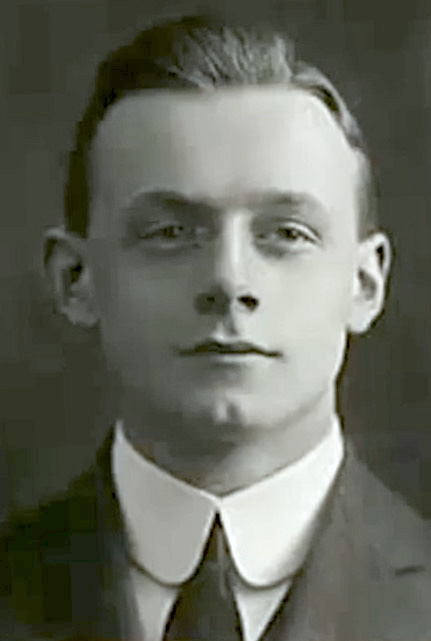 Young Rib, circa 1913What he did in Ottawa for a living during the next year is not entirely clear. Using a small legacy left to him by his mother, Rib began importing German wines and champagne, helping to supply Ottawa’s wealthy lumber barons, politicians and lobbyists with their favourite tipple. But his earnings could not have amounted to much. Other reports suggested that he was briefly a civil servant, or that he worked as a clerk, again at Molson’s Bank. But there is no solid evidence to support either contention. Others claimed that he was a German spy. While Rib might have been a bit of a snoop, this allegation is barely credible either. There was very little to spy on in pre-World War I Canada. Moreover, the German government was unlikely to employ a secret agent who was barely out of his teens. One thing certain, however, is that Rib made a huge splash on Ottawa’s small social scene.
Young Rib, circa 1913What he did in Ottawa for a living during the next year is not entirely clear. Using a small legacy left to him by his mother, Rib began importing German wines and champagne, helping to supply Ottawa’s wealthy lumber barons, politicians and lobbyists with their favourite tipple. But his earnings could not have amounted to much. Other reports suggested that he was briefly a civil servant, or that he worked as a clerk, again at Molson’s Bank. But there is no solid evidence to support either contention. Others claimed that he was a German spy. While Rib might have been a bit of a snoop, this allegation is barely credible either. There was very little to spy on in pre-World War I Canada. Moreover, the German government was unlikely to employ a secret agent who was barely out of his teens. One thing certain, however, is that Rib made a huge splash on Ottawa’s small social scene.
Fluent in English and French as well as German, the tall, elegant, blue-eyed Teuton presented a dashing figure, and was an immediate hit among Ottawa society debutantes. A champion schmoozer, he became a fixture at the best parties. Being an expert violinist, Rib also joined an amateur Ottawa orchestra deemed the best in Canada. This too facilitated his access to the cream of society who was starved for good entertainment. His first known appearance at a society event was at a Christmas charity function for needy children put on in December 1913 by the May Court Club. Rib helped Father Christmas hand out presents.
In May 1914, Rib appeared in Ottawa’s premier “Kermiss,” a charity theatrical event held at the Russell Theatre on behalf of the Victorian Order of Nurses. The production drew rave reviews. The Evening Citizen enthused that “not for many years has the capital seen a spectacle so surpassing in brilliance, so bewildering in its riot of color, yet so wholly enjoyable.” Powdered and bewigged, Rib performed a stately “Royal Minuet” with other young men and women of Ottawa’s high society.
The centre of the social whirl in Ottawa during those pre-war years was Rideau Hall, the residence of Canada’s Governor General, the Duke of Connaught. The German-speaking Duke was the third son of Queen Victoria. His wife was Princess Louise Margaret of Prussia. Rib was introduced to the vice-regal couple, by Arthur Fitzpatrick, the son of Canada’s Chief Justice, Sir Charles Fitzpatrick. The suave and debonair German was invited to Rideau Hall for dinner on at least two occasions, where he conversed with the Duchess in her first language.
Rib was also popular with the young men of the city. At his rooms at the Sherbrooke boarding house located at the corner of O’Connor and Slater Streets, Rib installed parallel bars, a flying swing, and a vaulting horse. There, he entertained his friends with gymnastic feats. In the evenings, he dined regularly with other residents of the house, which included a reporter for the Ottawa Free Press, an employee at the Parliamentary Library, an Ashbury College teacher, and a public servant. Never the retiring type, Rib told his friends that “a great future was in store for him.” Rib had few vices. Despite being a wine seller, he was a teetotaller. While he enjoyed a game of poker, he never played for large stakes. On weekends, he went for walks in Rockcliffe, or played tennis at the Rideau Club. Considered one of the Club’s best players, you could count on Rib to turn out nattily attired in court whites, completed with a black bow tie. In the winter of 1913-14, Rib also joined the Minto Skating Club, and accompanied its skating team to a competition that February for the “Ellis Memorial Trophy” in Boston.
This charmed existence came to an end with Rib’s hurried departure for New York on that fateful August day. He left without paying a number of bills. Sometime after Rib had left the country, his doctor received a letter requesting that his medical bill be sent to an address in Switzerland. The $156 bill, a large sum in those days, was paid in full. Rib neglected, however, to pay his druggist, Harry Skinner of Wellington Street, to whom he owed $1.38. And he never repaid the $10 he borrowed from James Sherwood.
The “Ottawa lad” known as “Rib” to his friends was indeed destined to go far…and to fall even farther. Better known to the world as Joachim von Ribbentrop, he became Germany’s Minister for Foreign Affairs in 1938, the architect of the Russian-German non-aggression pact that immediately preceded the start of World War II. The pleasant young man that had charmed Ottawa high society a quarter century earlier had morphed into an ardent Nazi, fanatically loyal to Adolph Hitler. Following his trial by the Allies in Nuremburg after the war, he was hanged on 16 October, 1946 for war crimes, including his participation in Nazi efforts to exterminate Europe’s Jews.
Sources:
Bloch, Michael, 1992. Ribbentrop, A Biography, Crown Publishers, Inc.
Gwyn, Sandra, 1992. Tapestry of War, Harper Collins, Toronto.
Lawson, Robert, 2007. “Joachim von Ribbentrop in Canada, 1910-1914, A Note,” The International History Review, Vol. 29, No. 4.
von Ribbentrop, Joachim 1954. The Ribbentrop Memoirs, Weidenfeld and Nicolson, London, 1954.
Schwartz, Paul, 1943. This Man Ribbentrop: His Life and Times, Julian Messner Inc. New York.
Boston Evening Transcript, “Boston Skaters Winners,” 24 February 1914.
Hamilton Spectator, “Ribbentrop Sold His Wines in Ottawa,” 15 December 1945.
Ottawa Journal, “Ottawa’s Premier Kermiss Was a Feast of Song and Dance for Charity,” 6 May 1914.
—————–, “In Ottawa, Von Rib Foresaw Great Future, 15 June 1945.
——————, “Von Rib’s Days in Ottawa, Nazi Gangster Has C.S. Post, Paid Up Physician in Full,” 16 June 1945.
The Evening Citizen, “The Kermiss,” 6 May 1914.
Toronto Daily Star, “Ribbentrop a Cad Owed Ottawa Bill,” 16 June 1945.
Image: “Rib,” 1913, unknown.
Image: Reichsaussenminister, 1938, unknown.
Story written by James Powell, the author of the blog Today in Ottawa's History.
Retired from the Bank of Canada, James is the author or co-author of three books dealing with some aspect of Canadian history. These comprise: A History of the Canadian Dollar, 2005, Bank of Canada, The Bank of Canada of James Elliott Coyne: Challenges, Confrontation and Change,” 2009, Queen’s University Press, and with Jill Moxley, Faking It! A History of Counterfeiting in Canada, 2013, General Store Publishing House, Renfrew, Ontario. James is a Director of The Historical Society of Ottawa.



